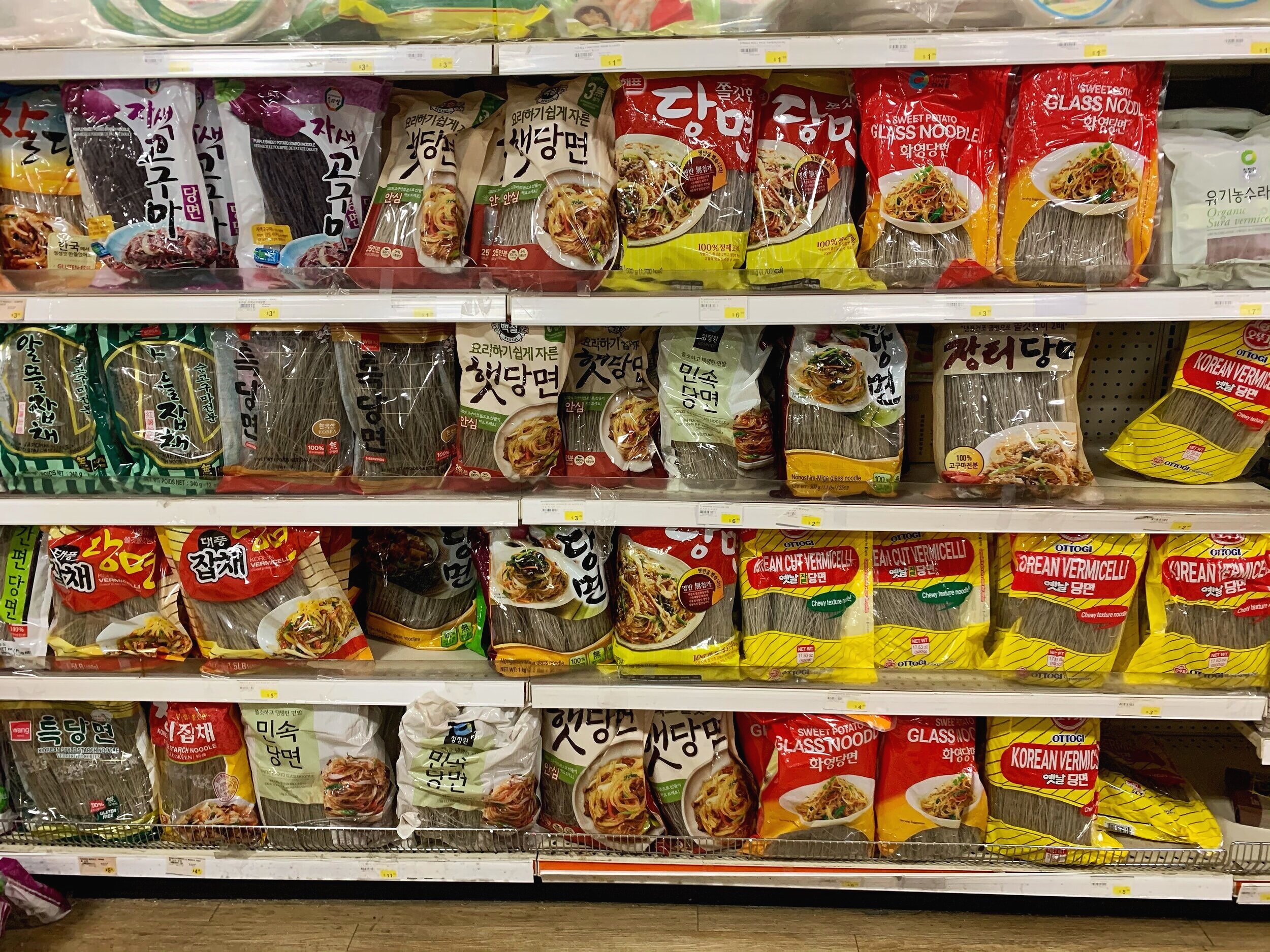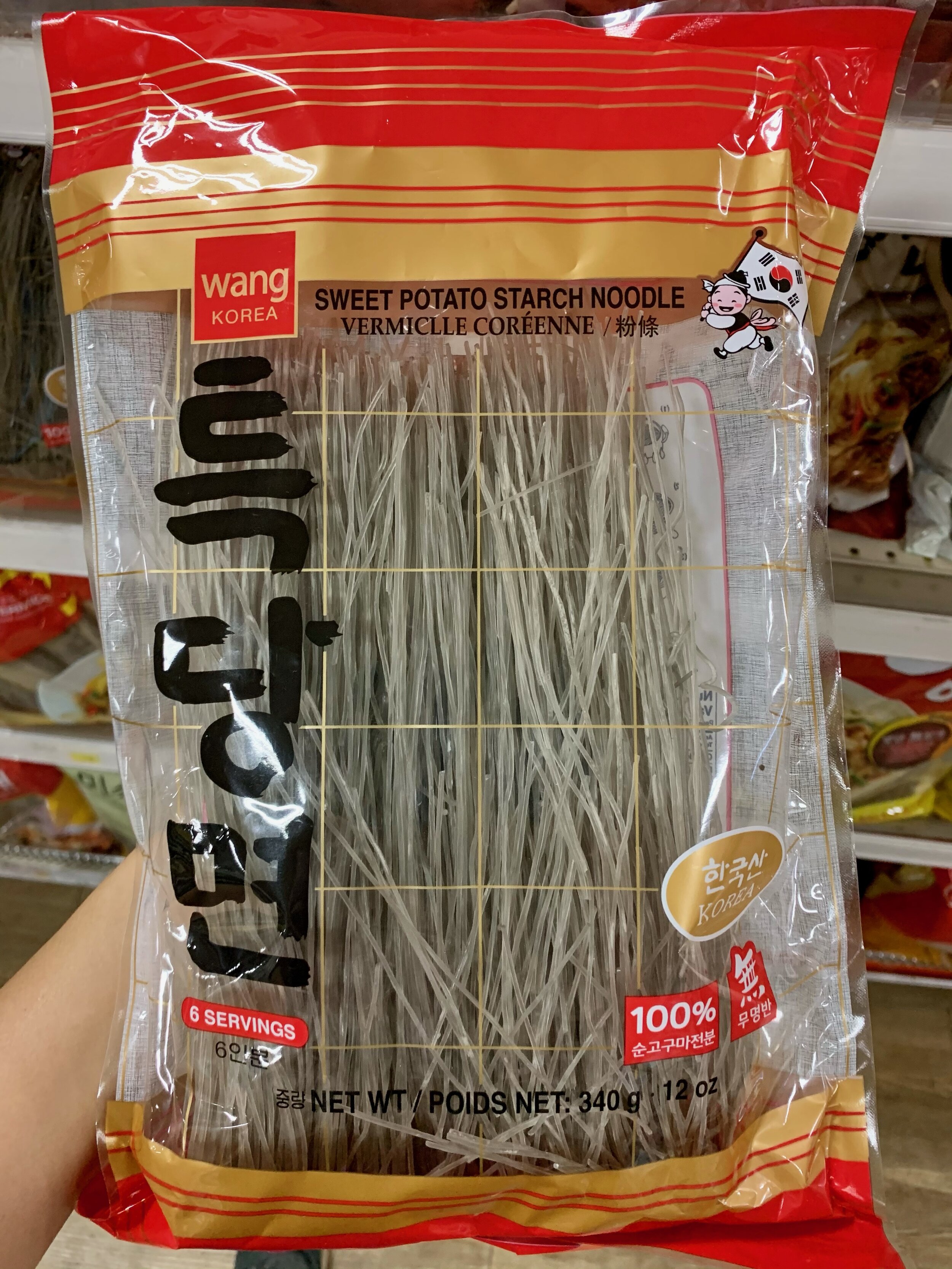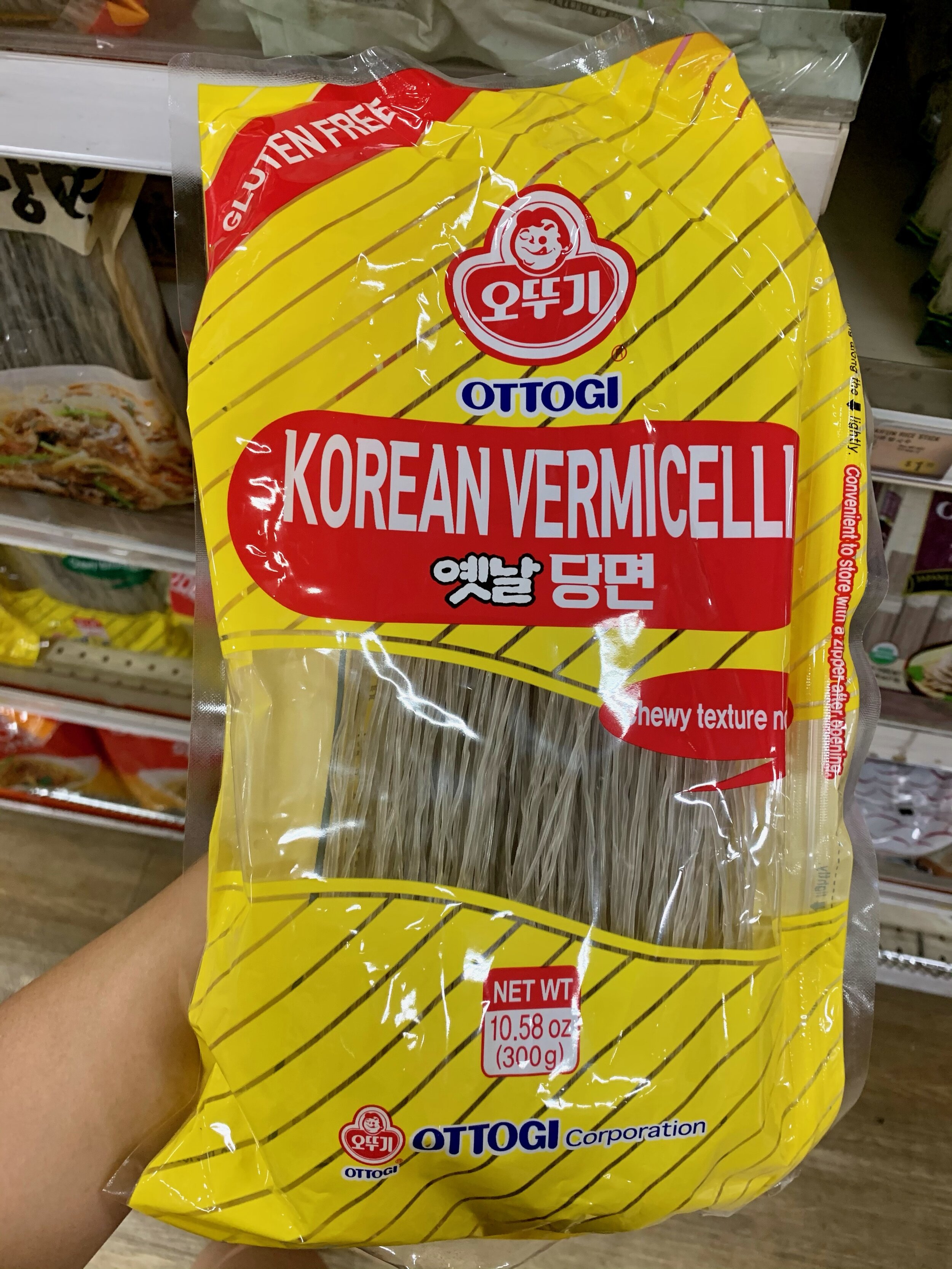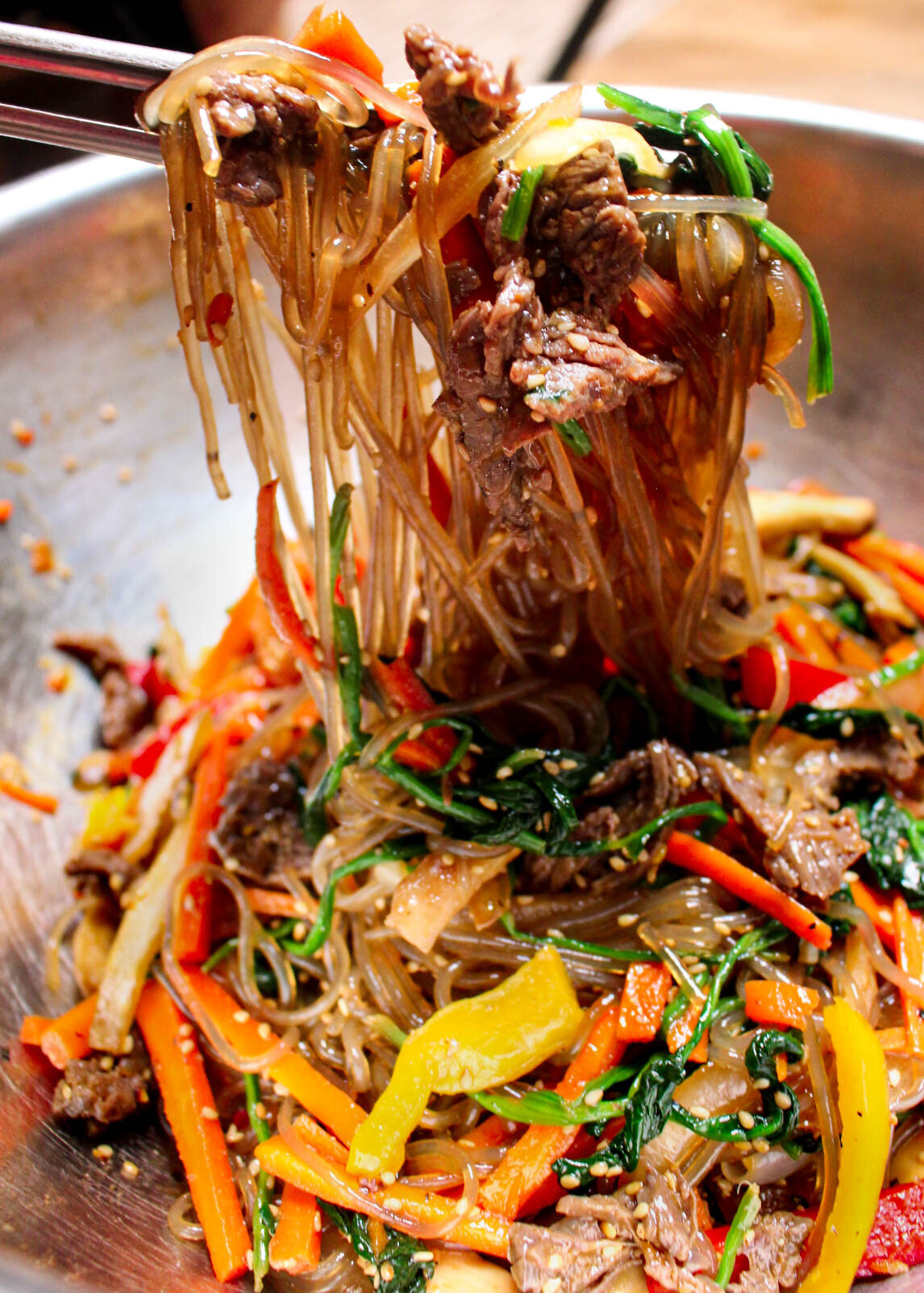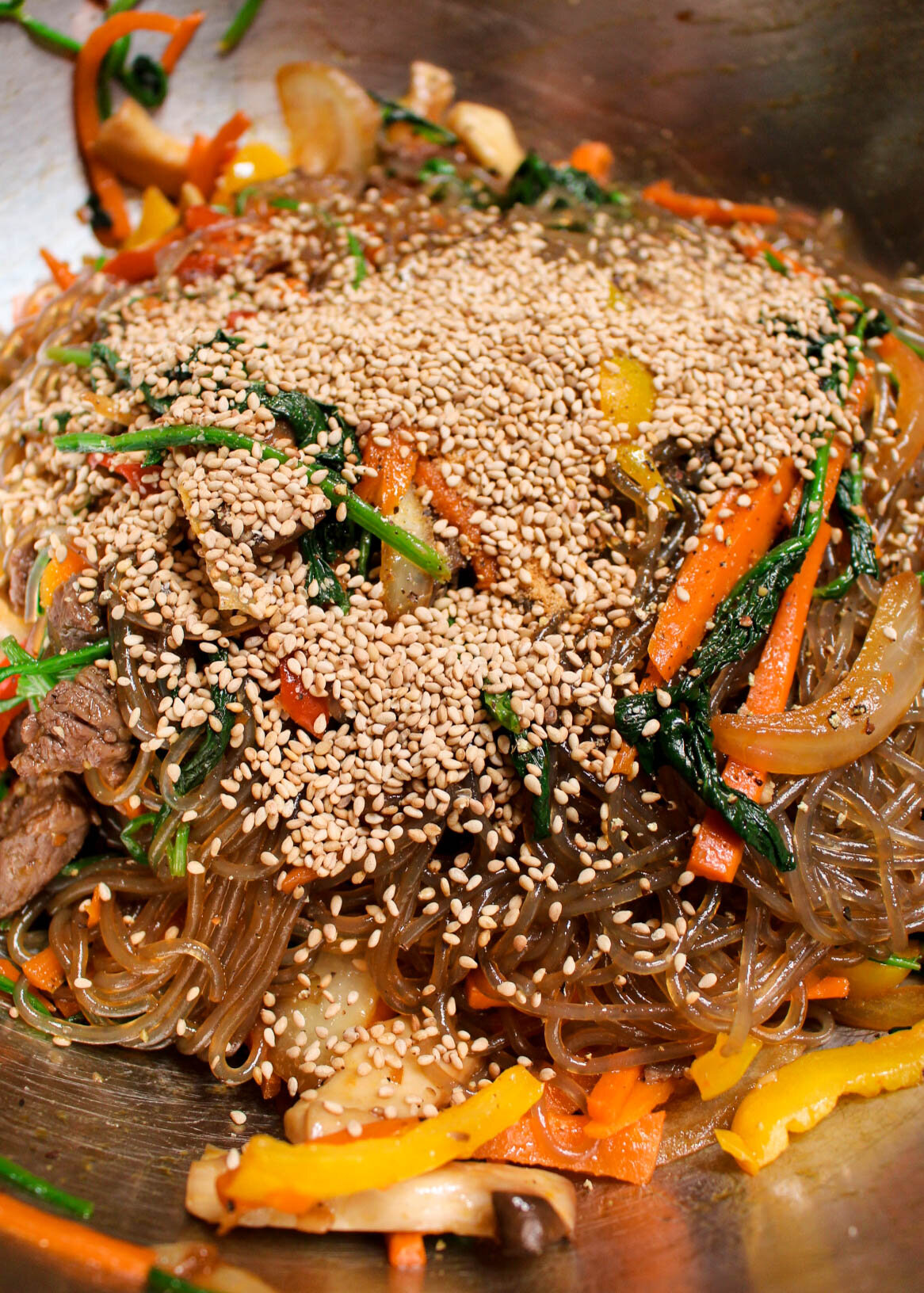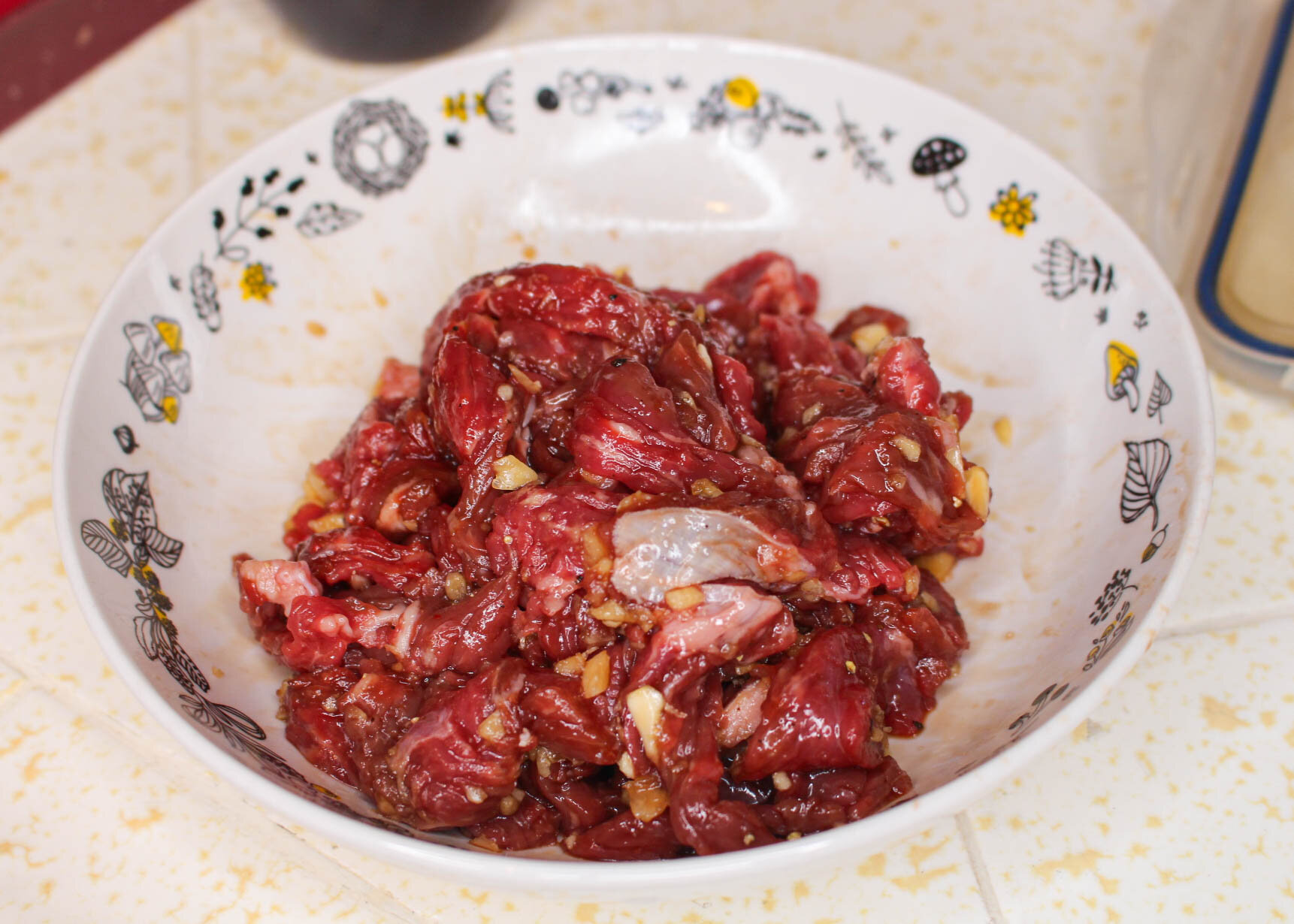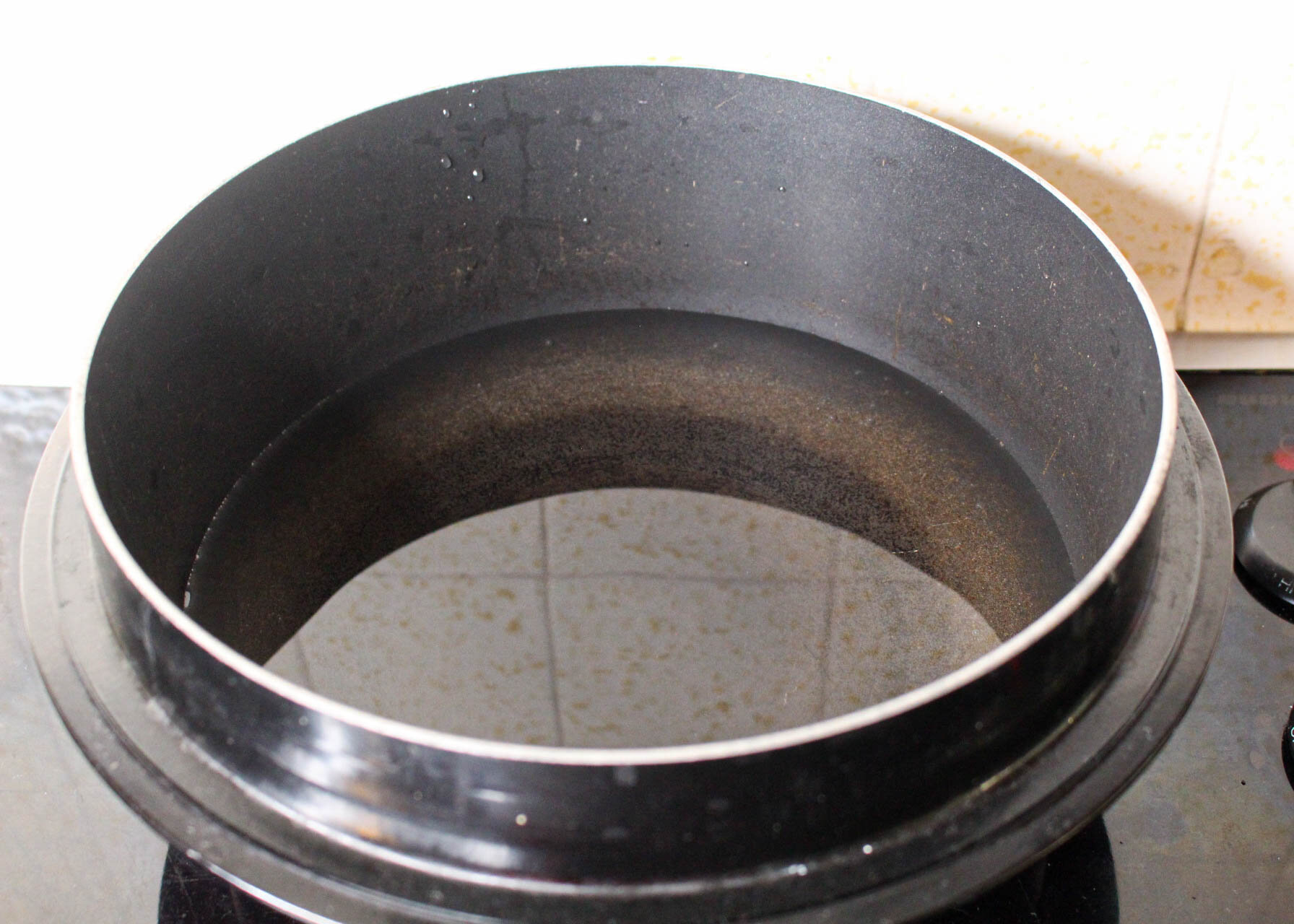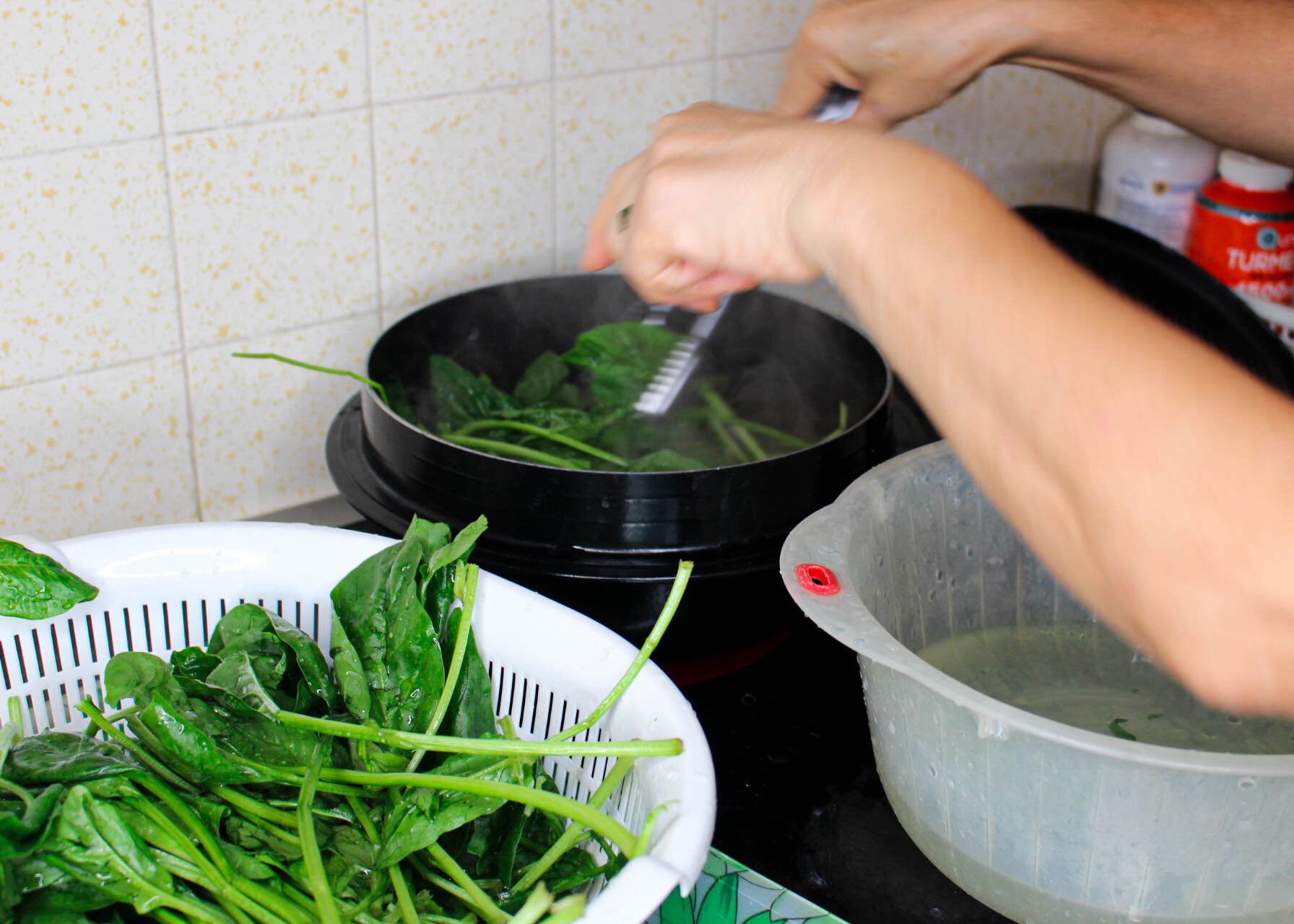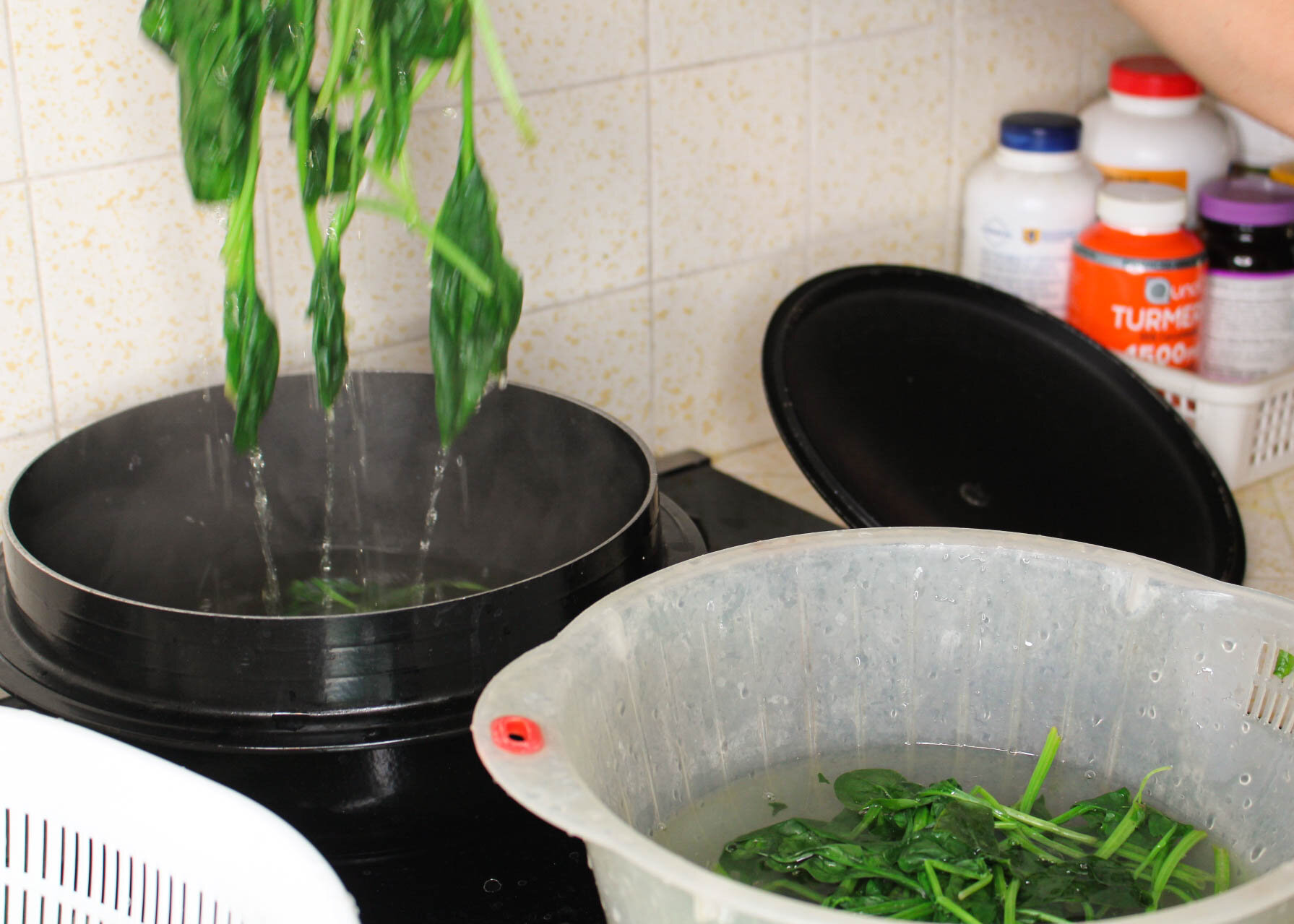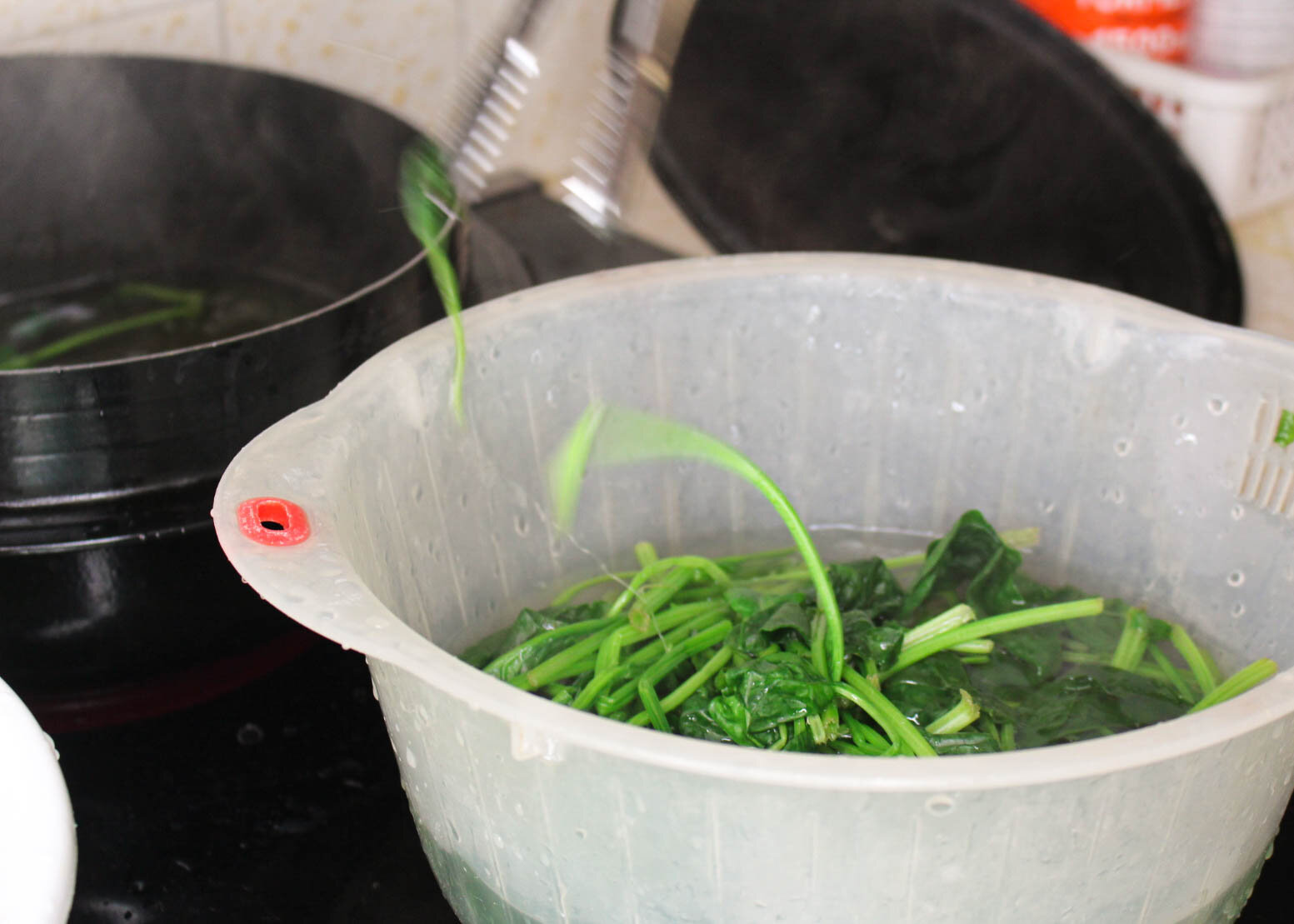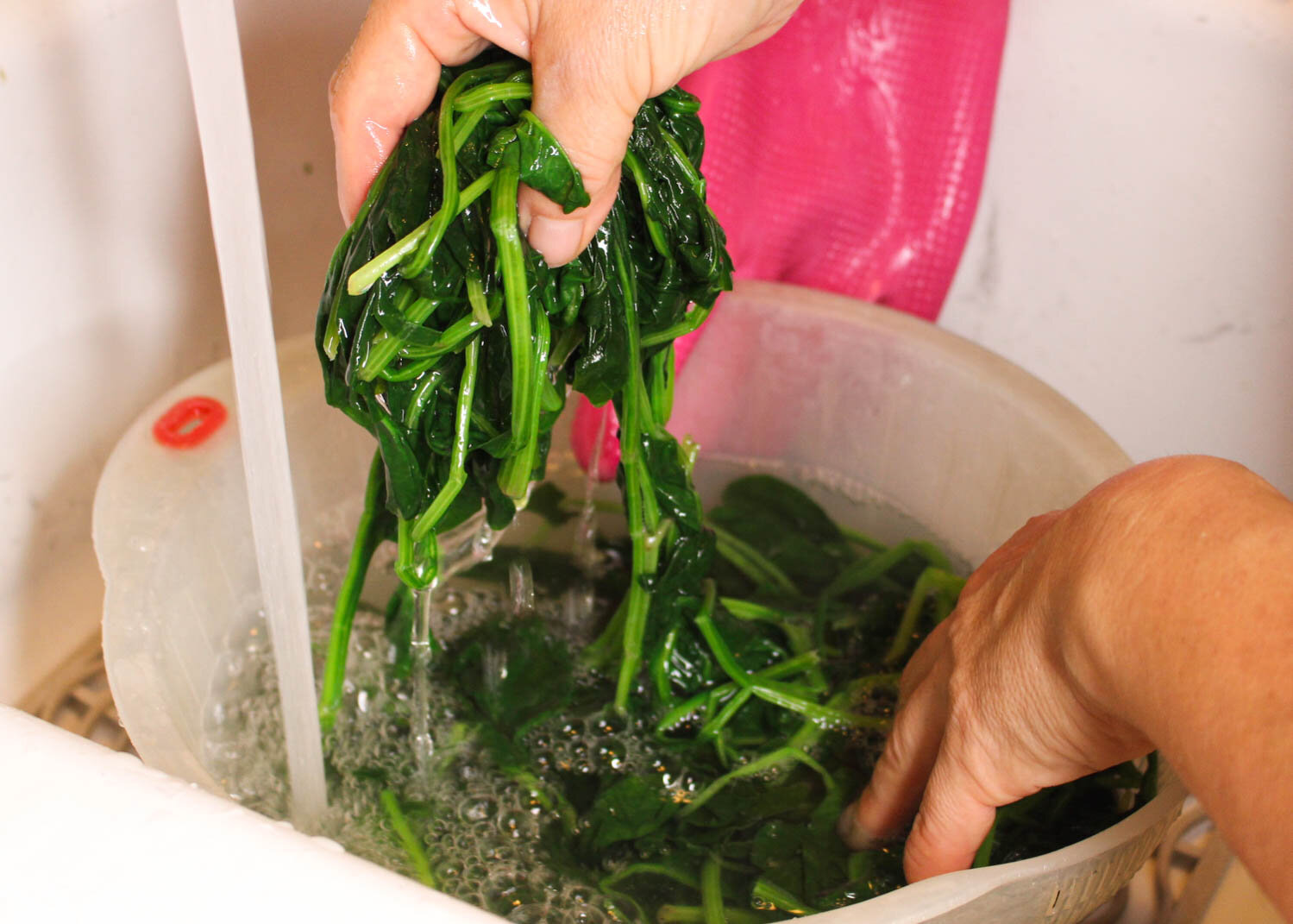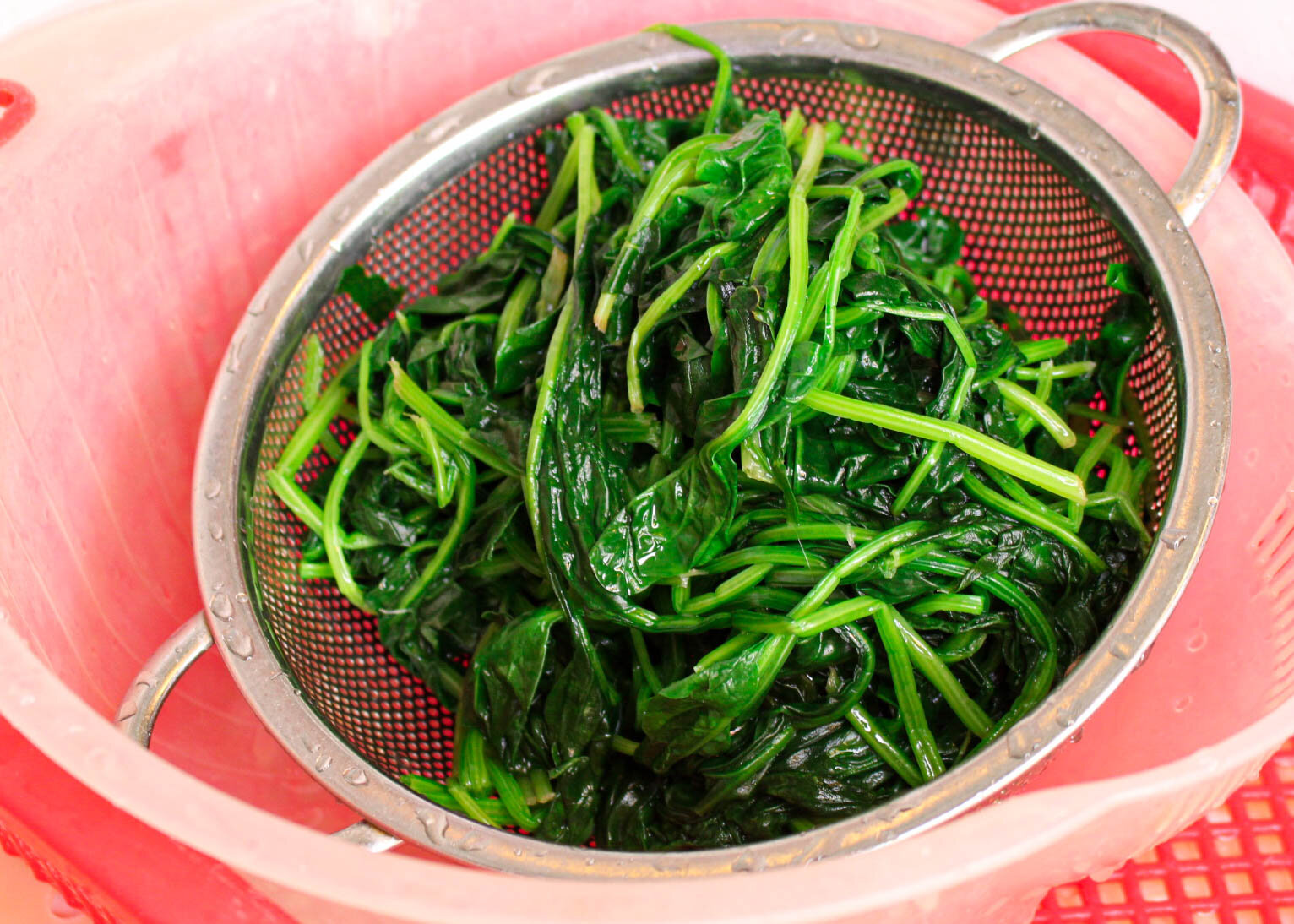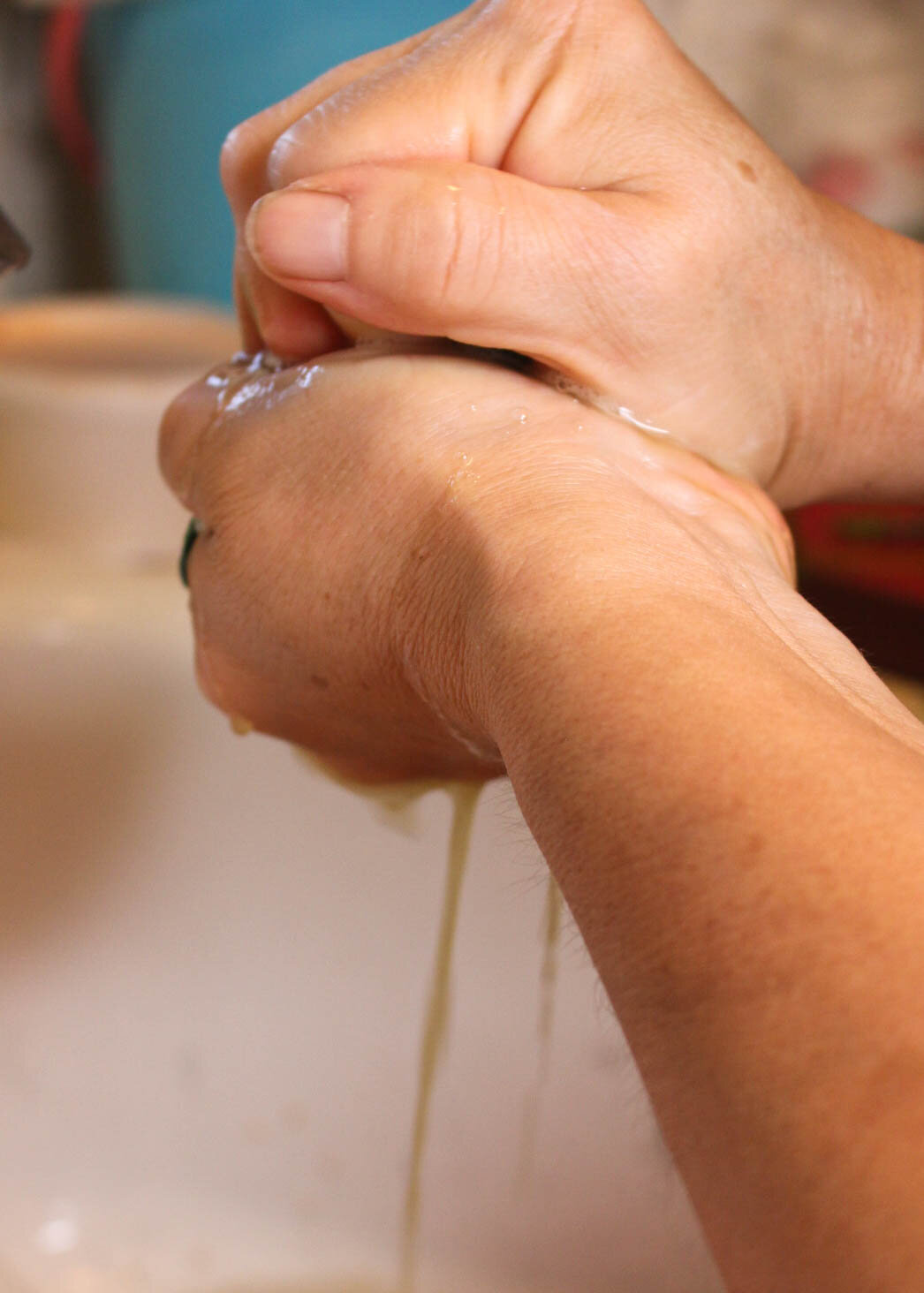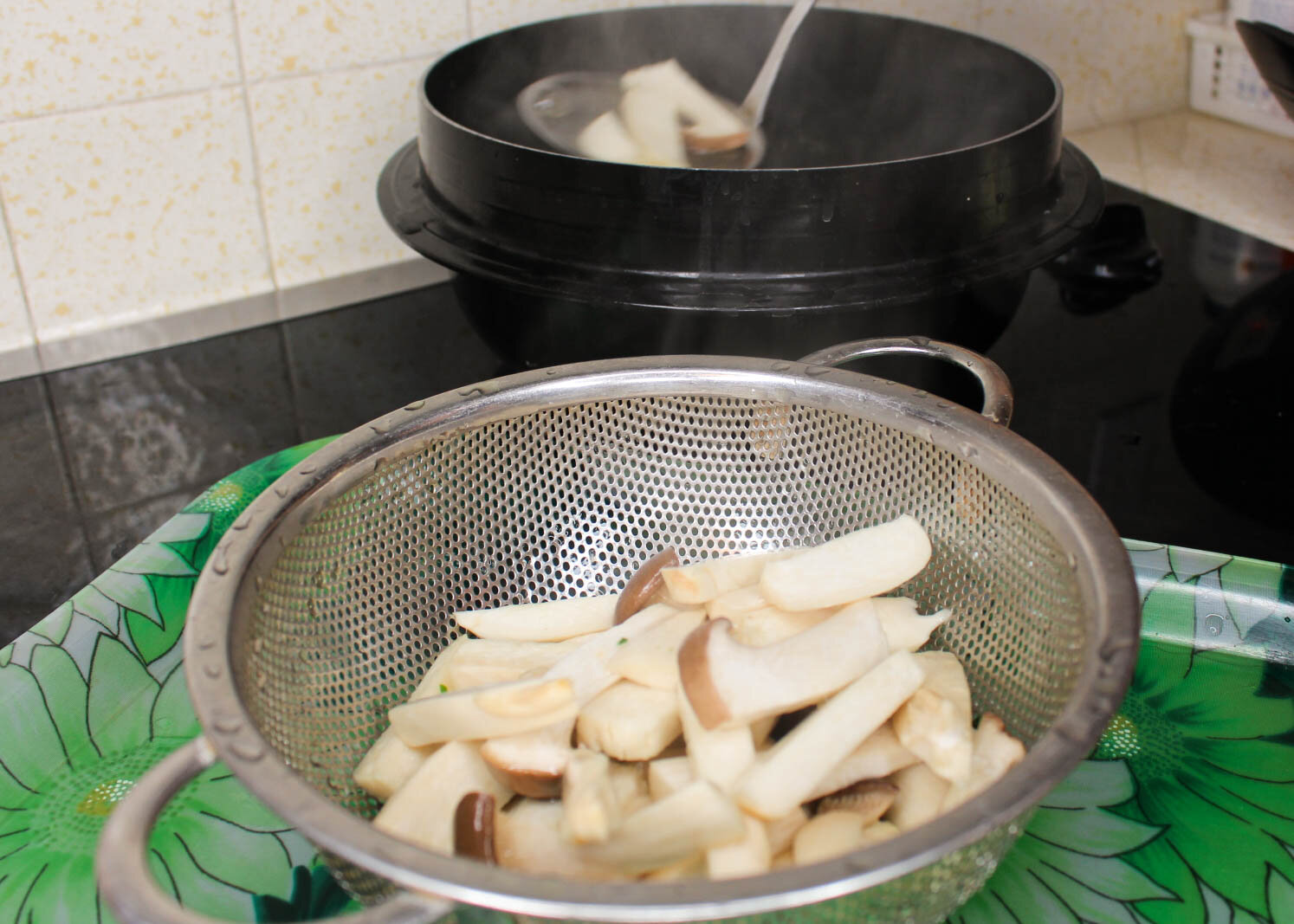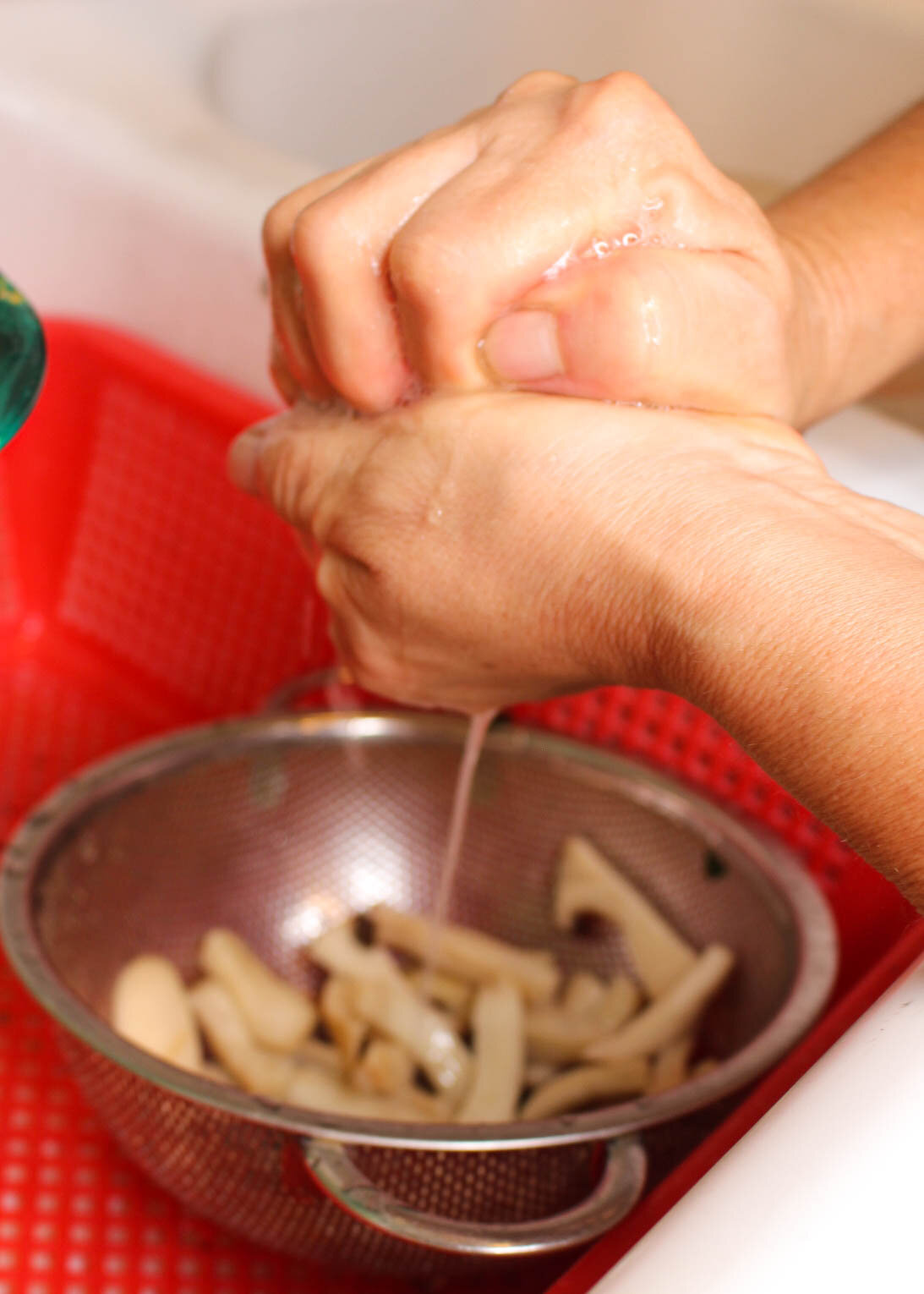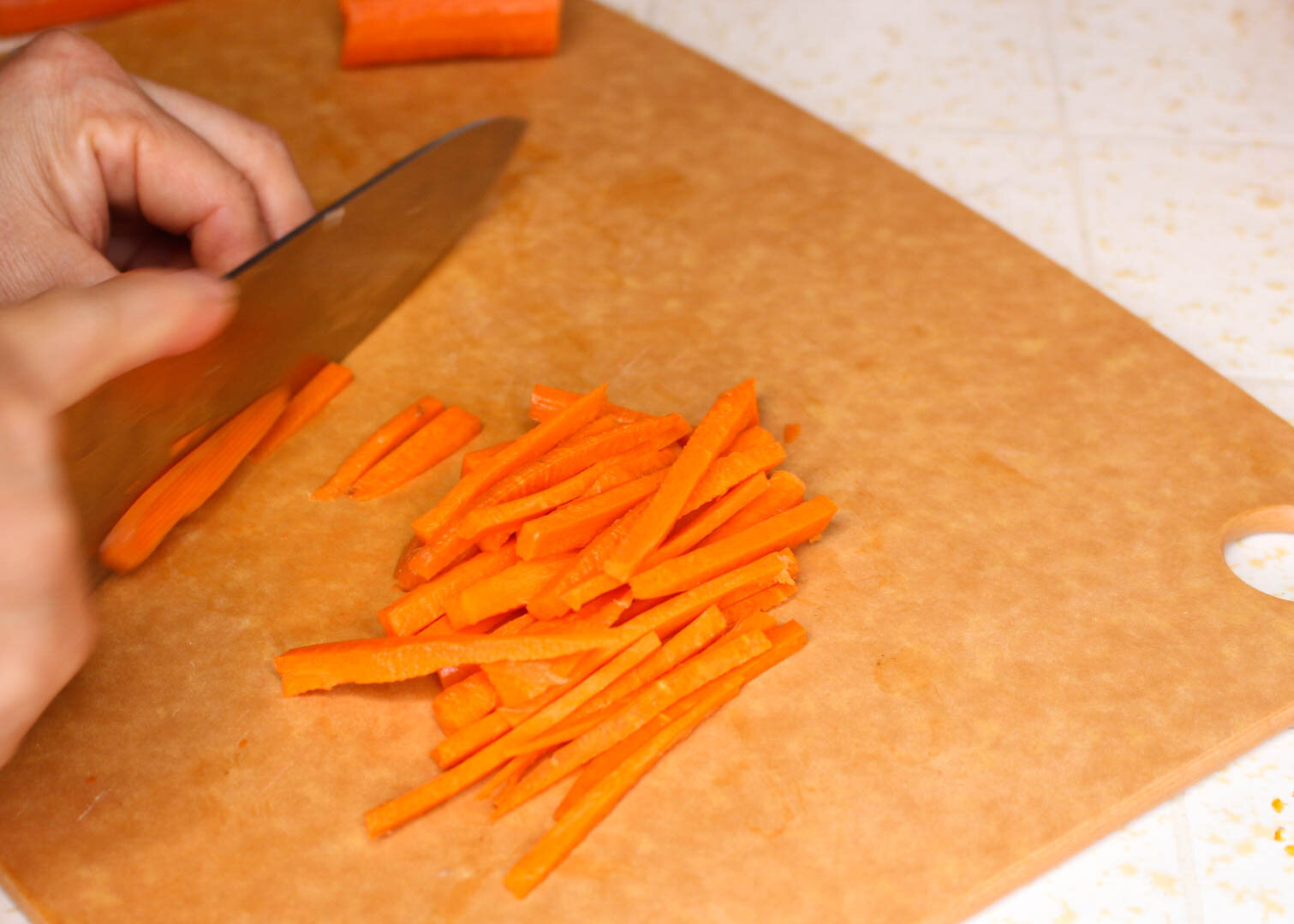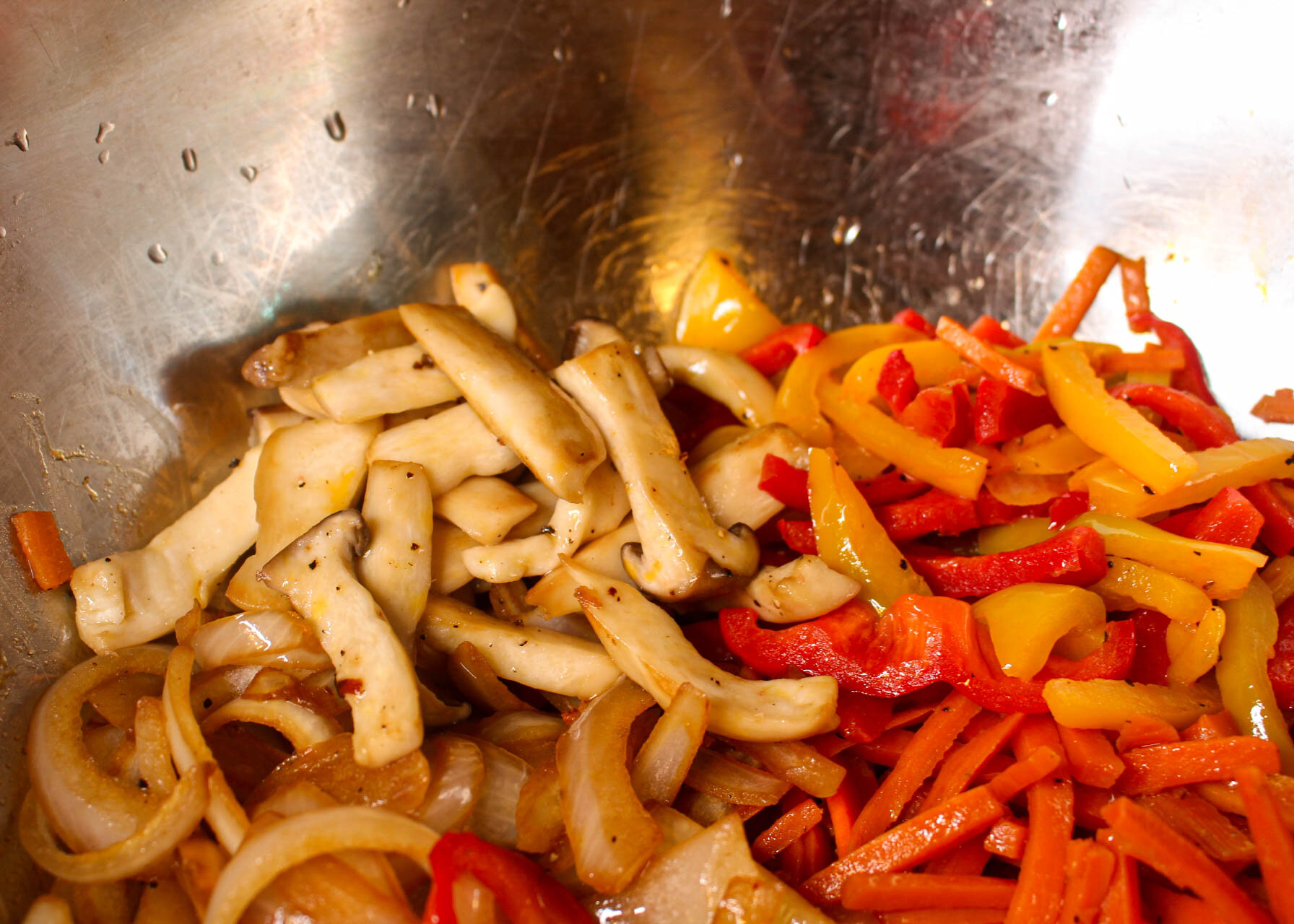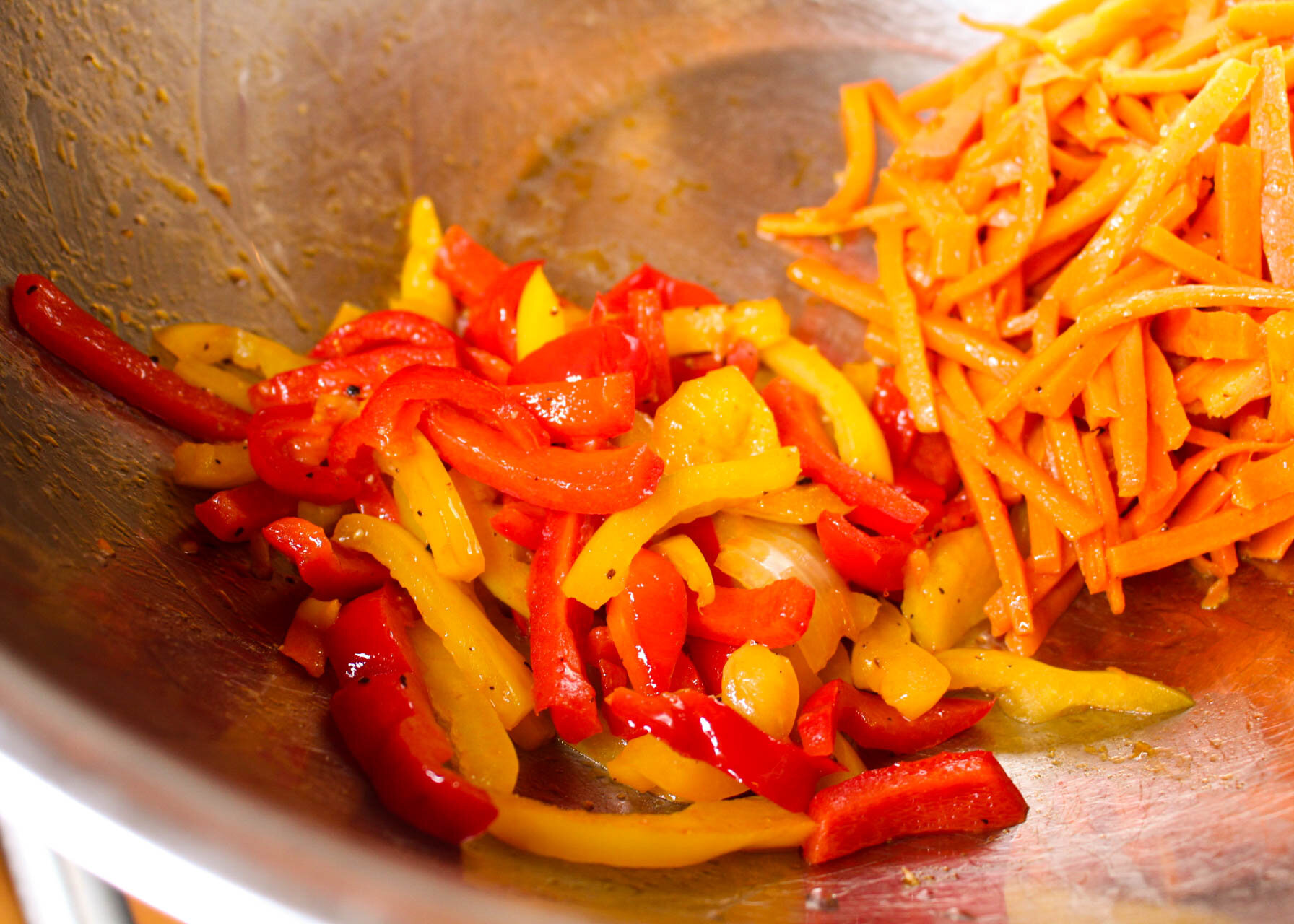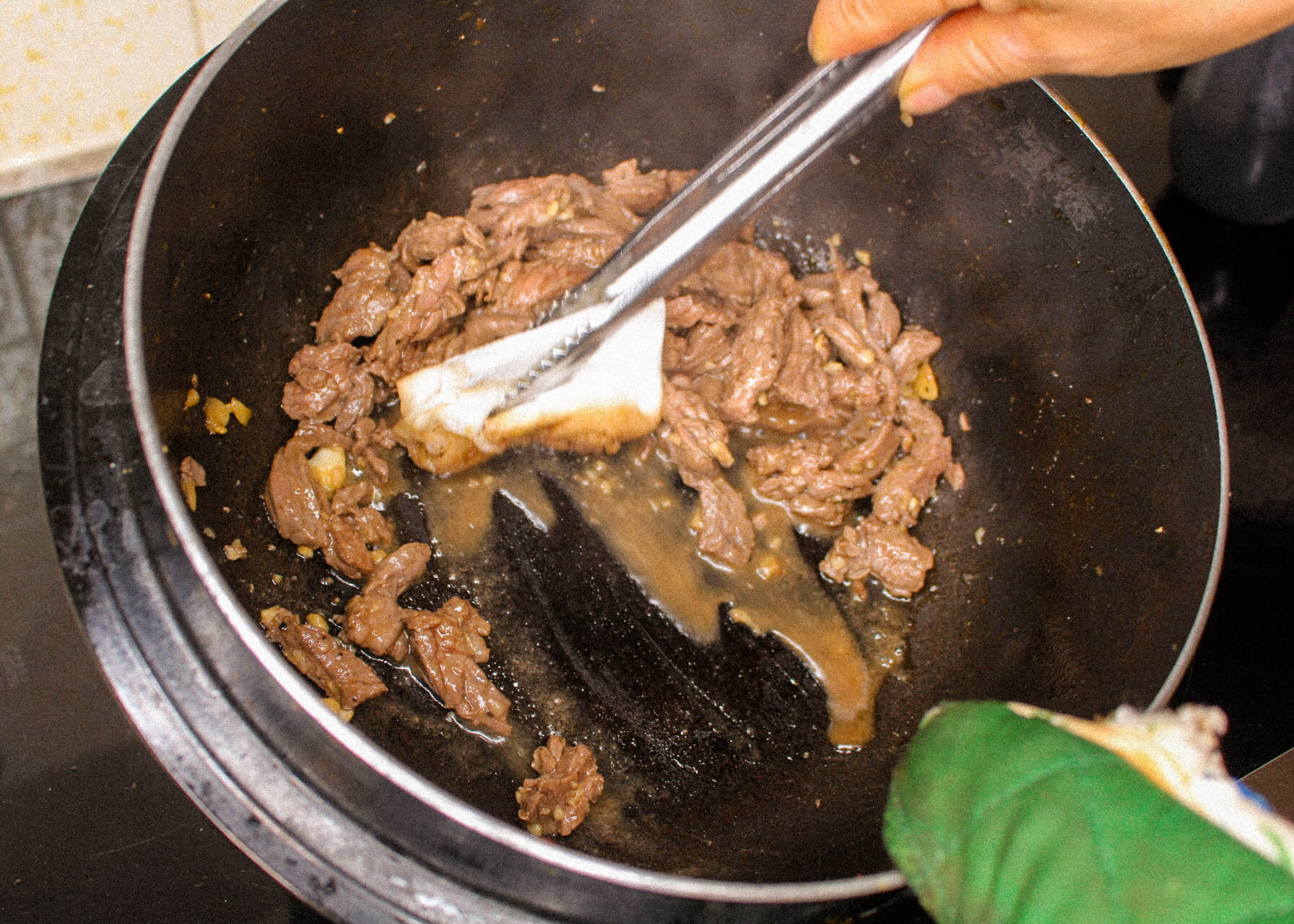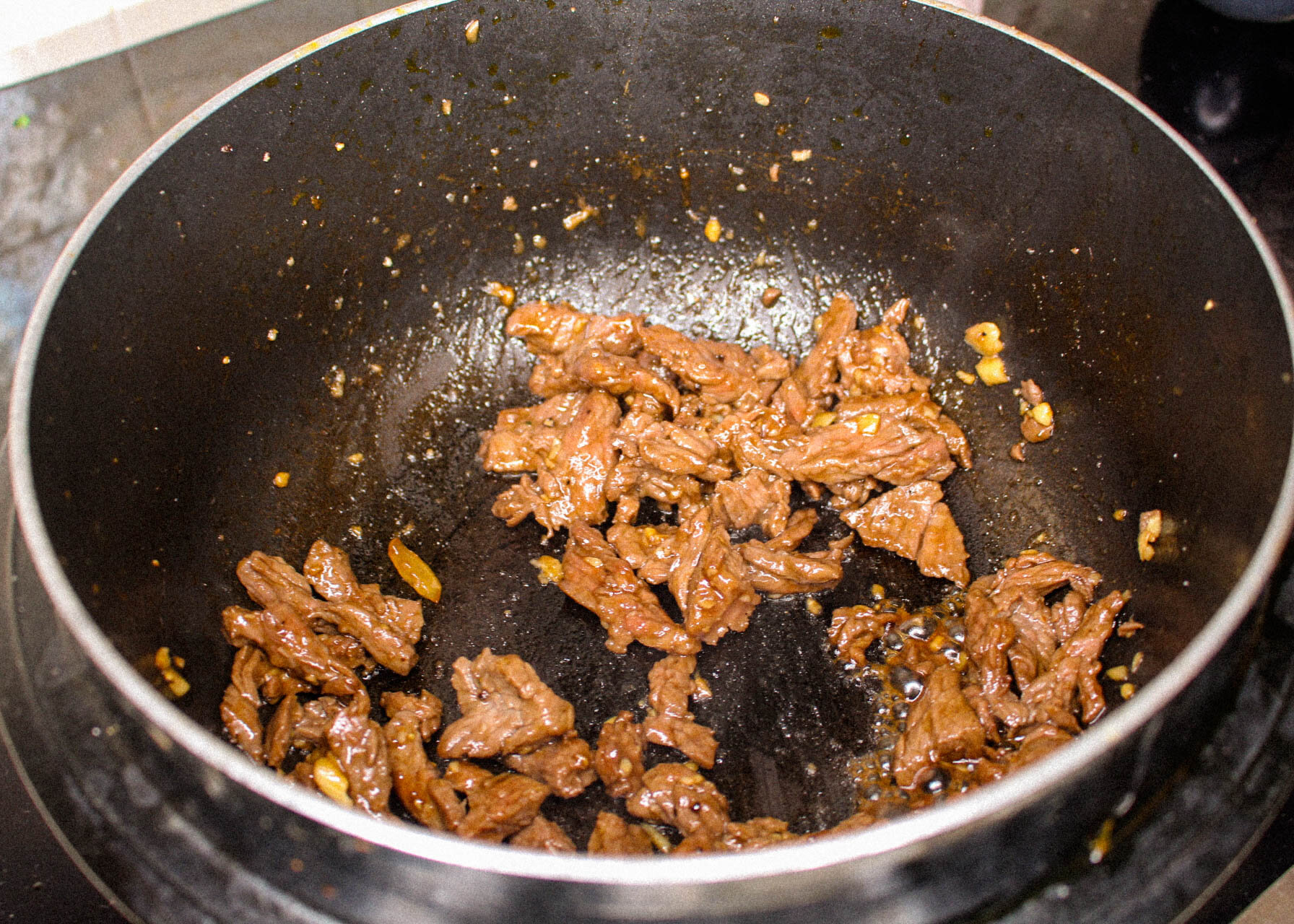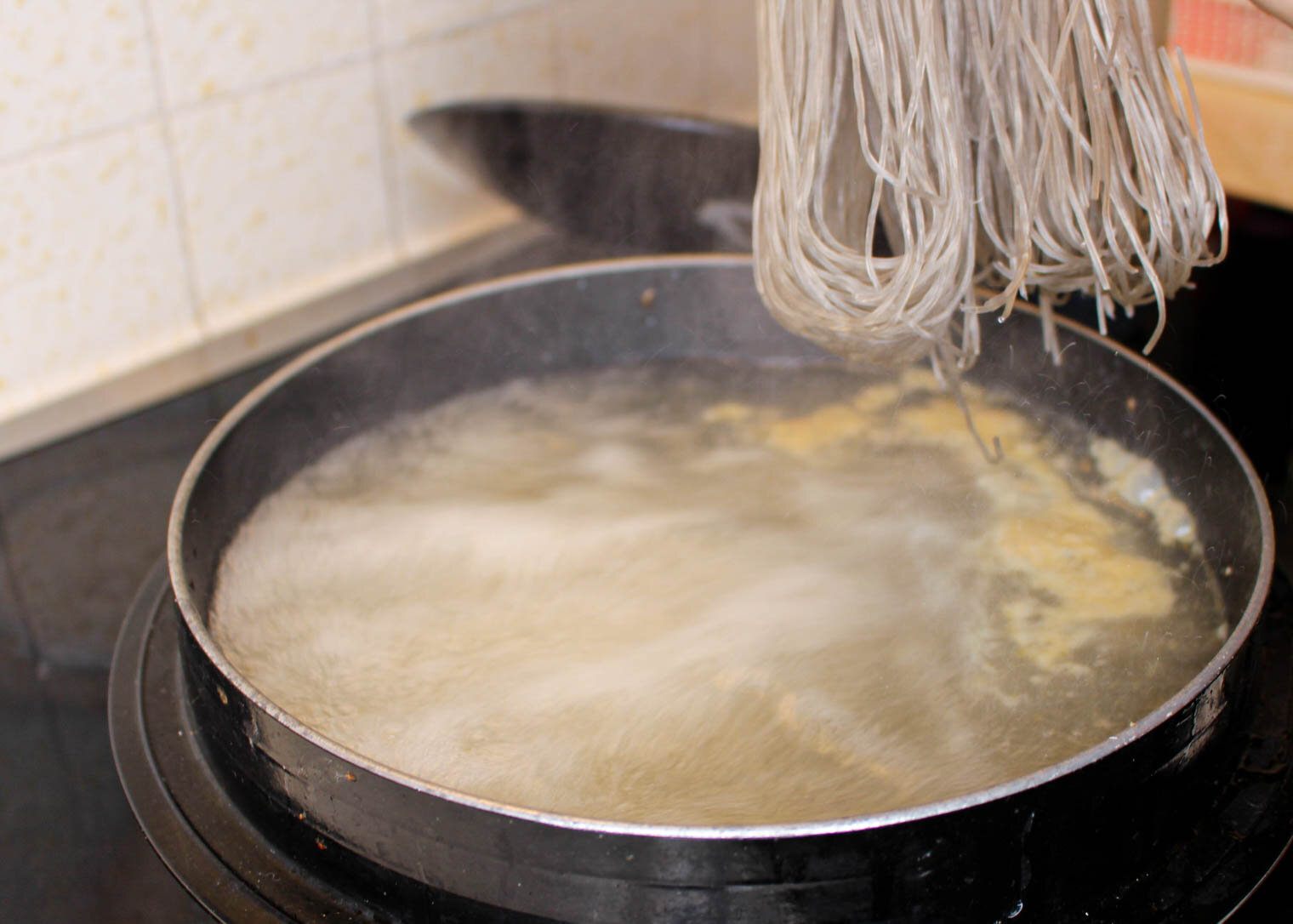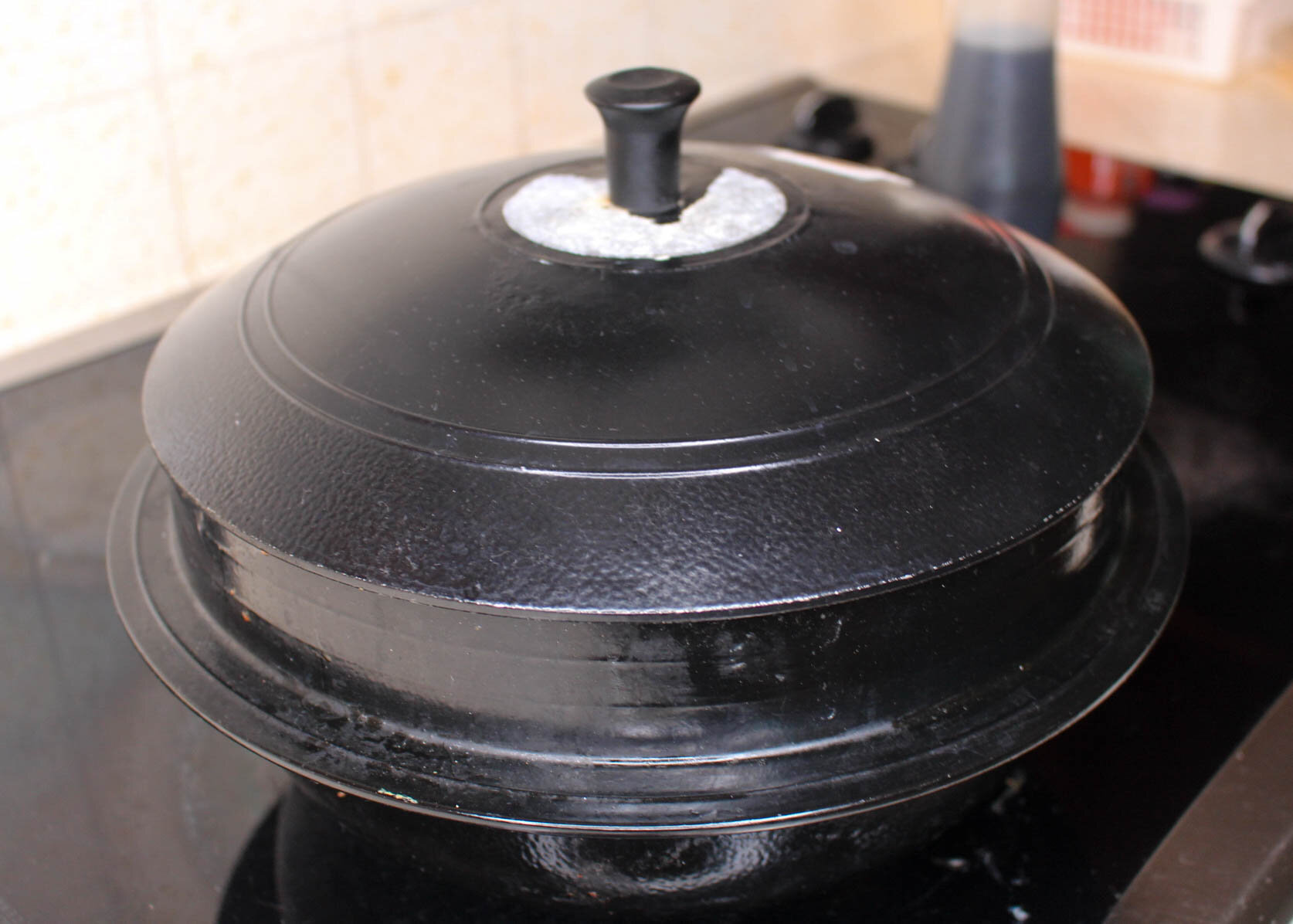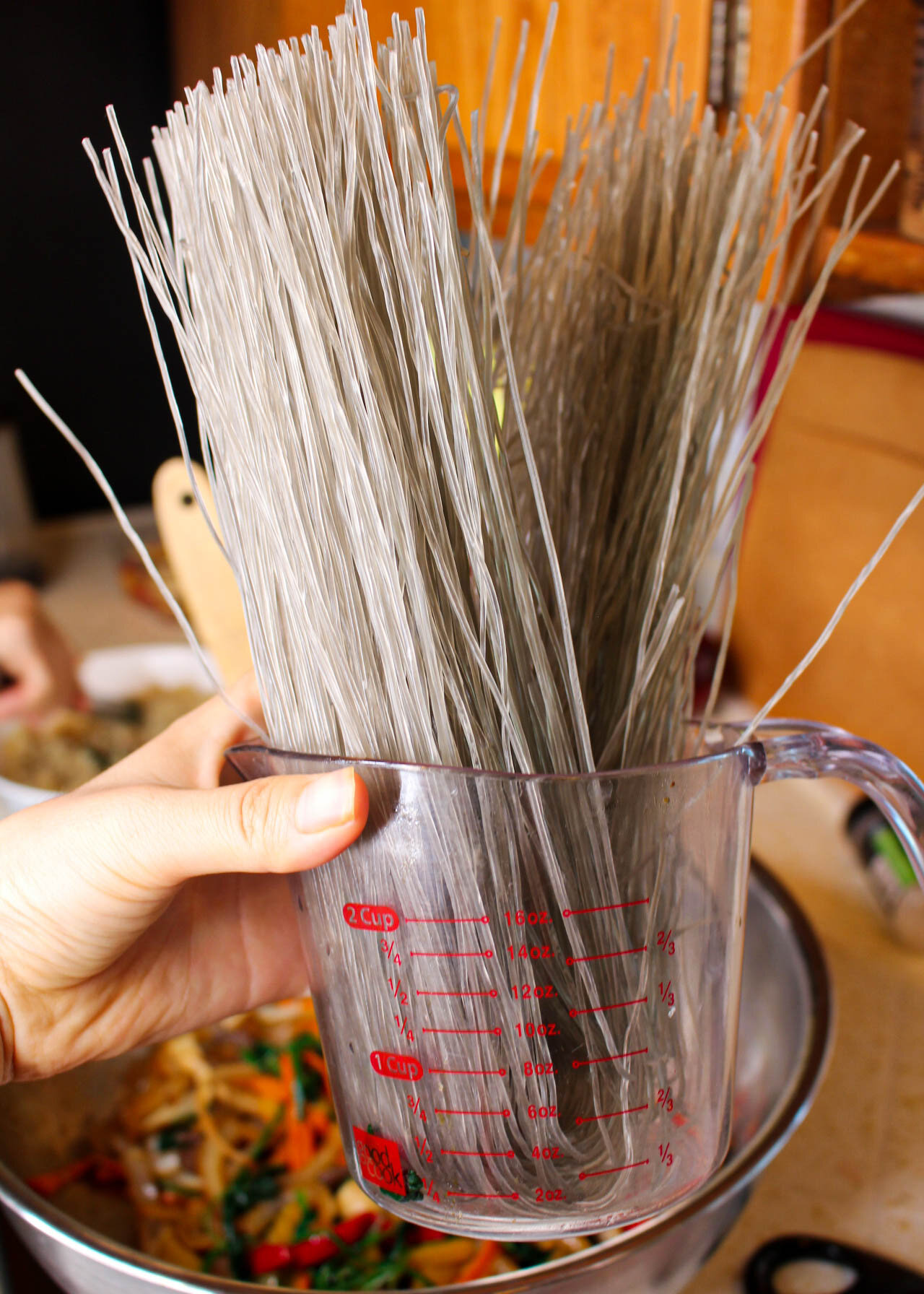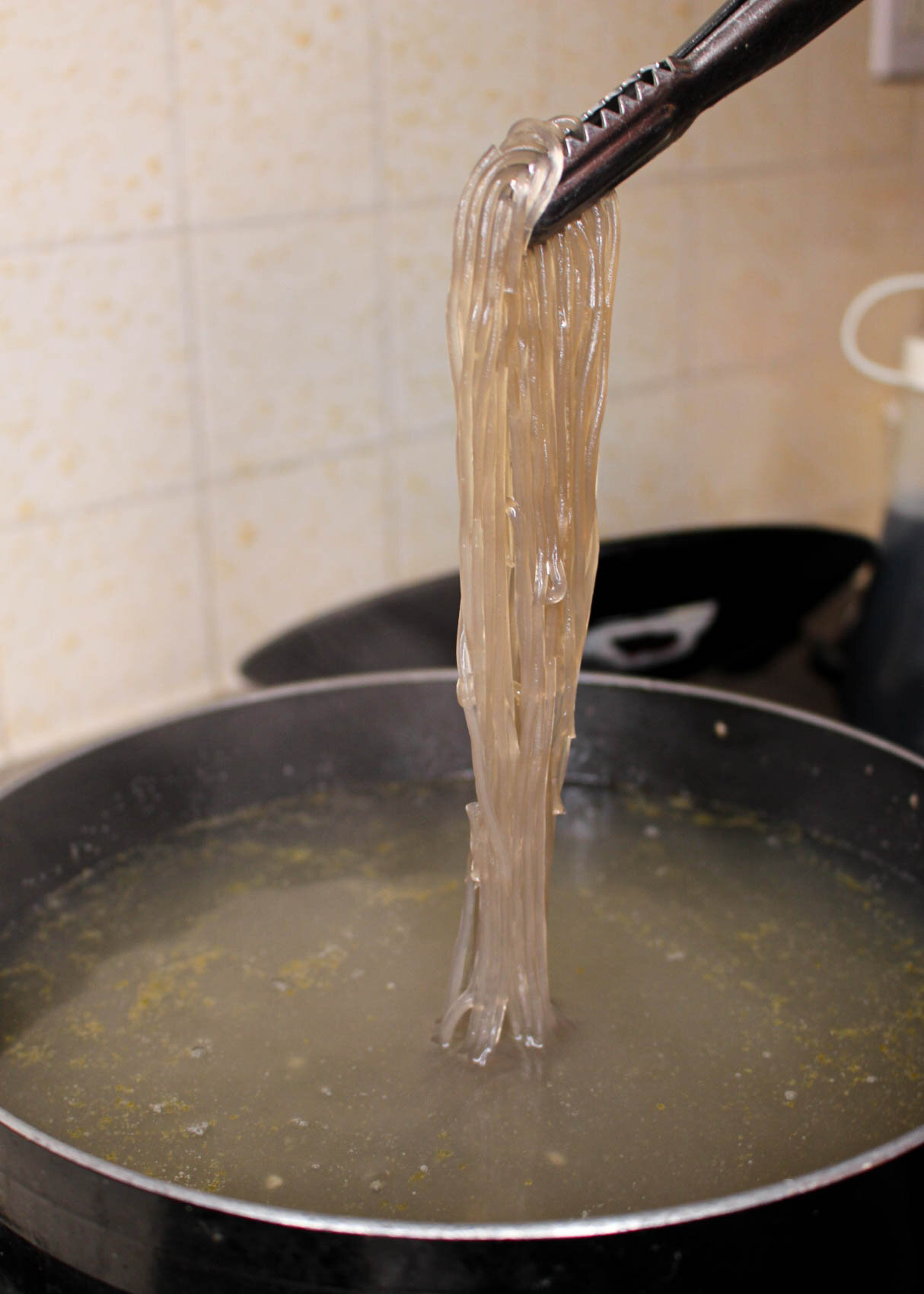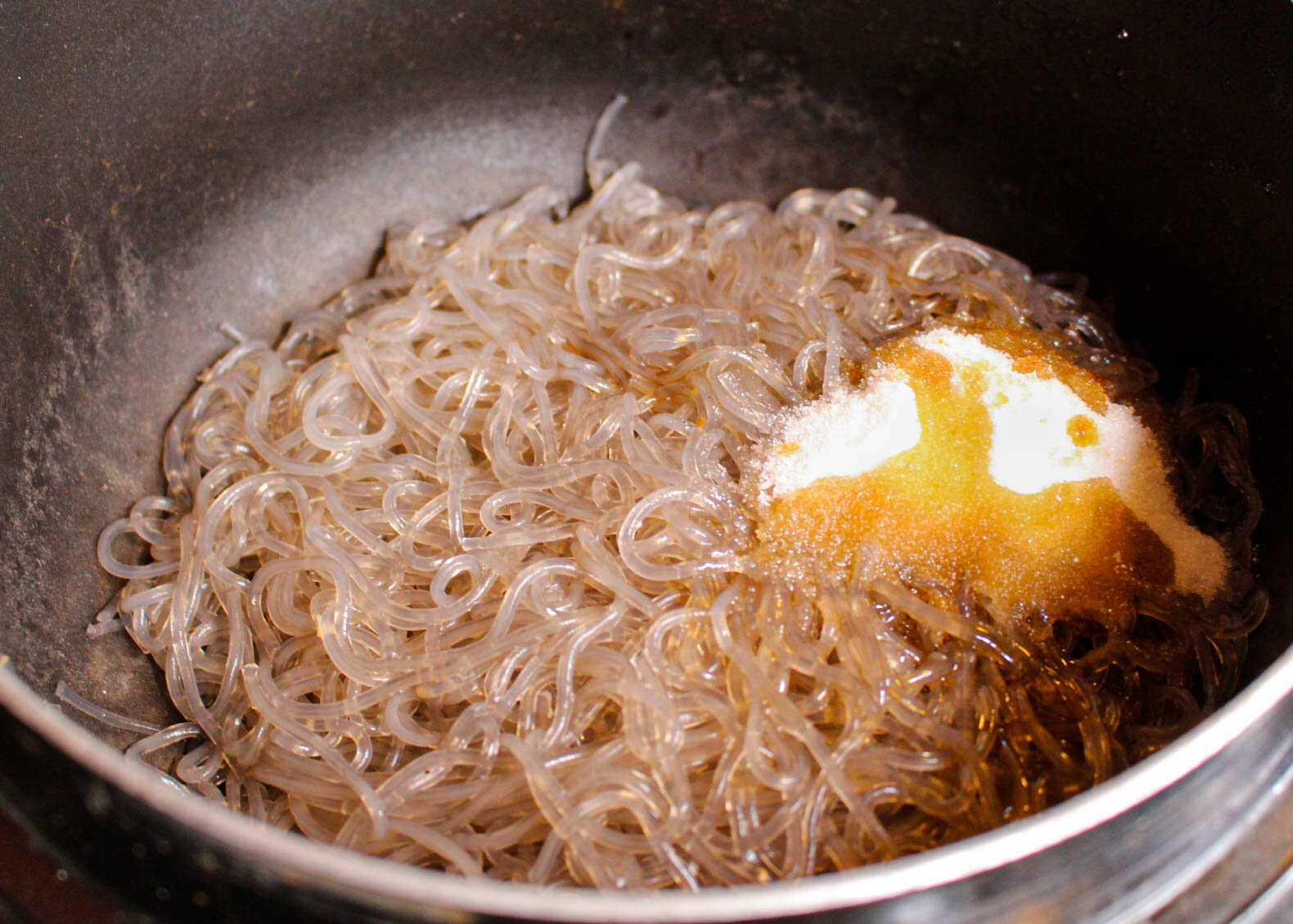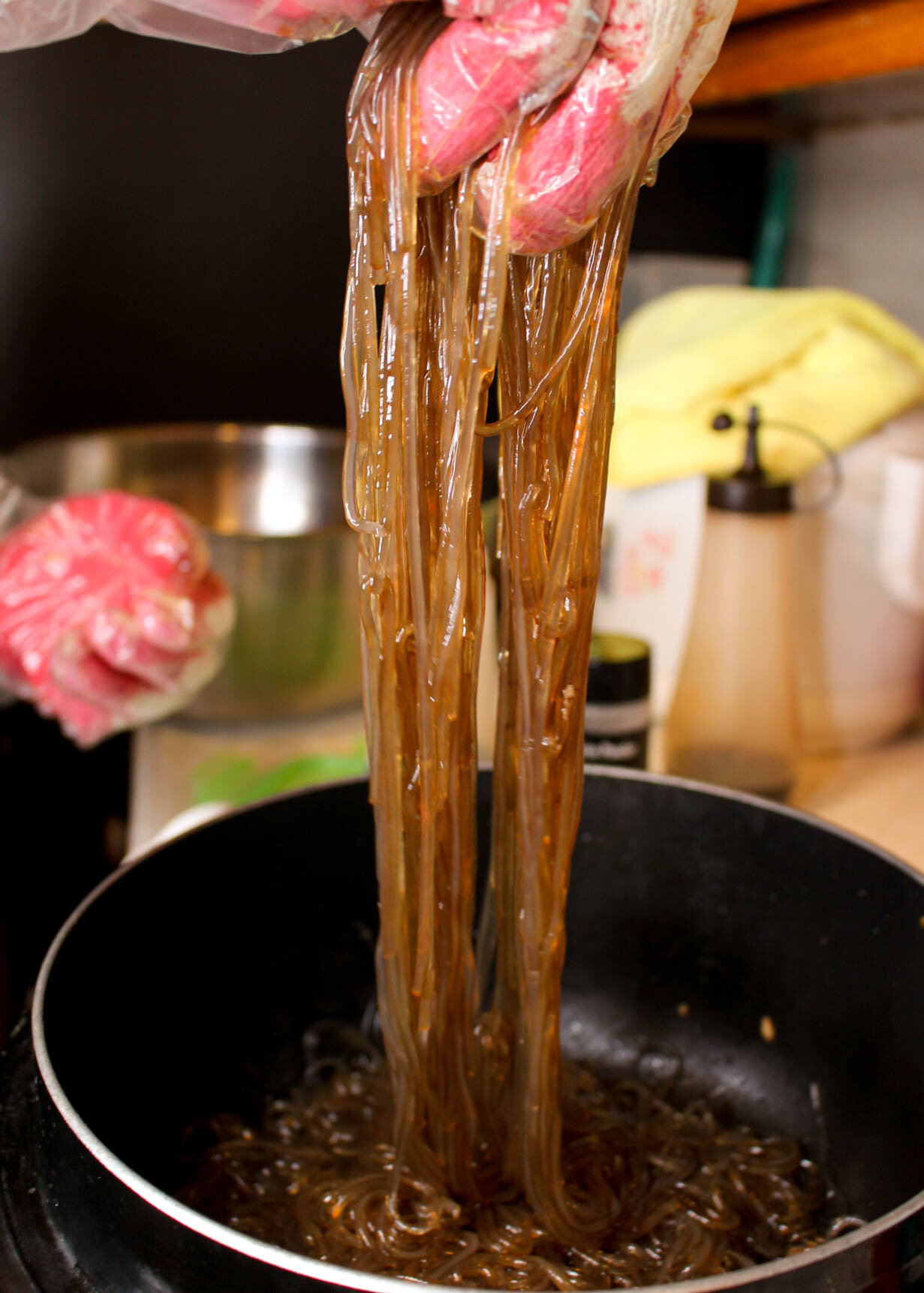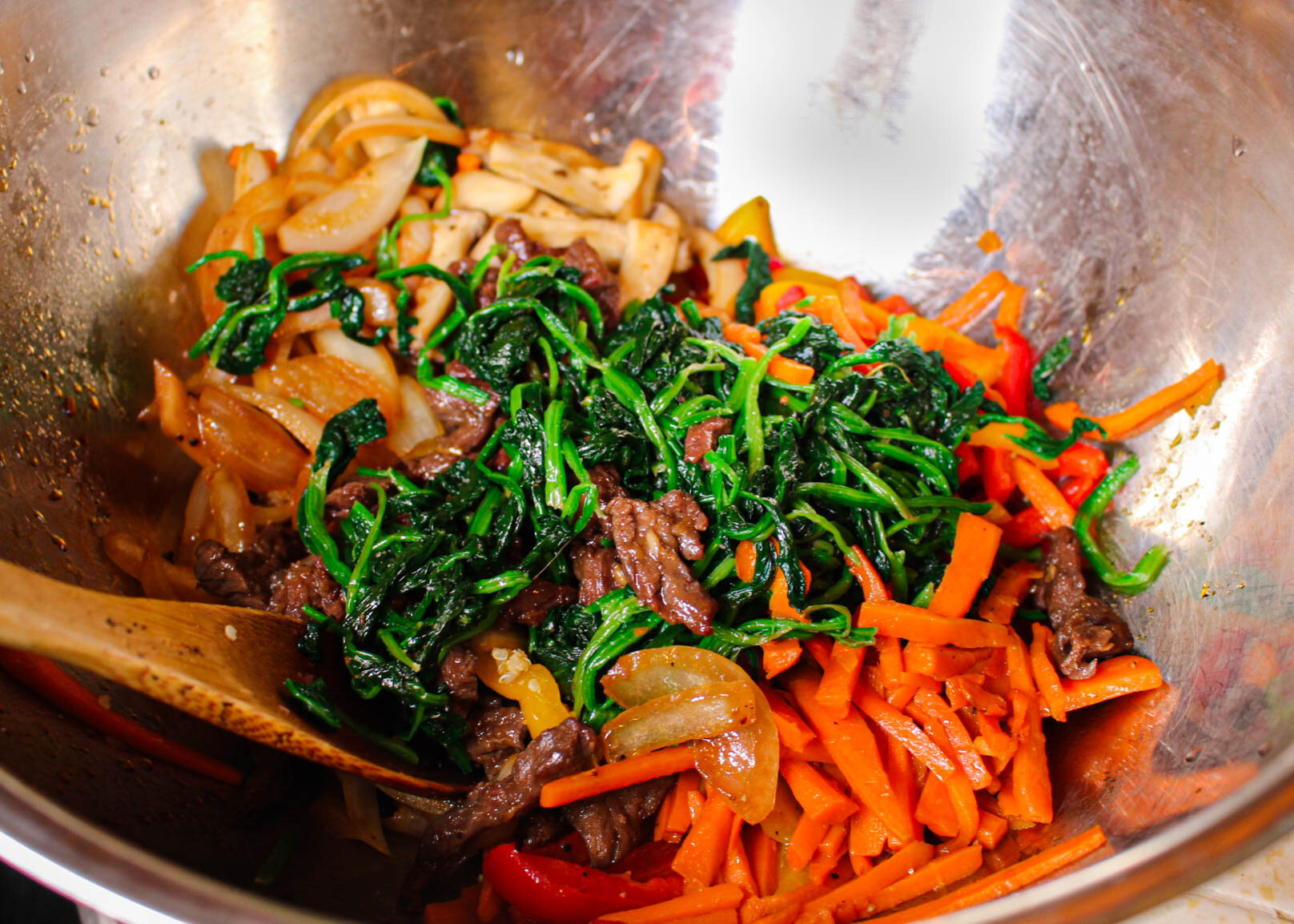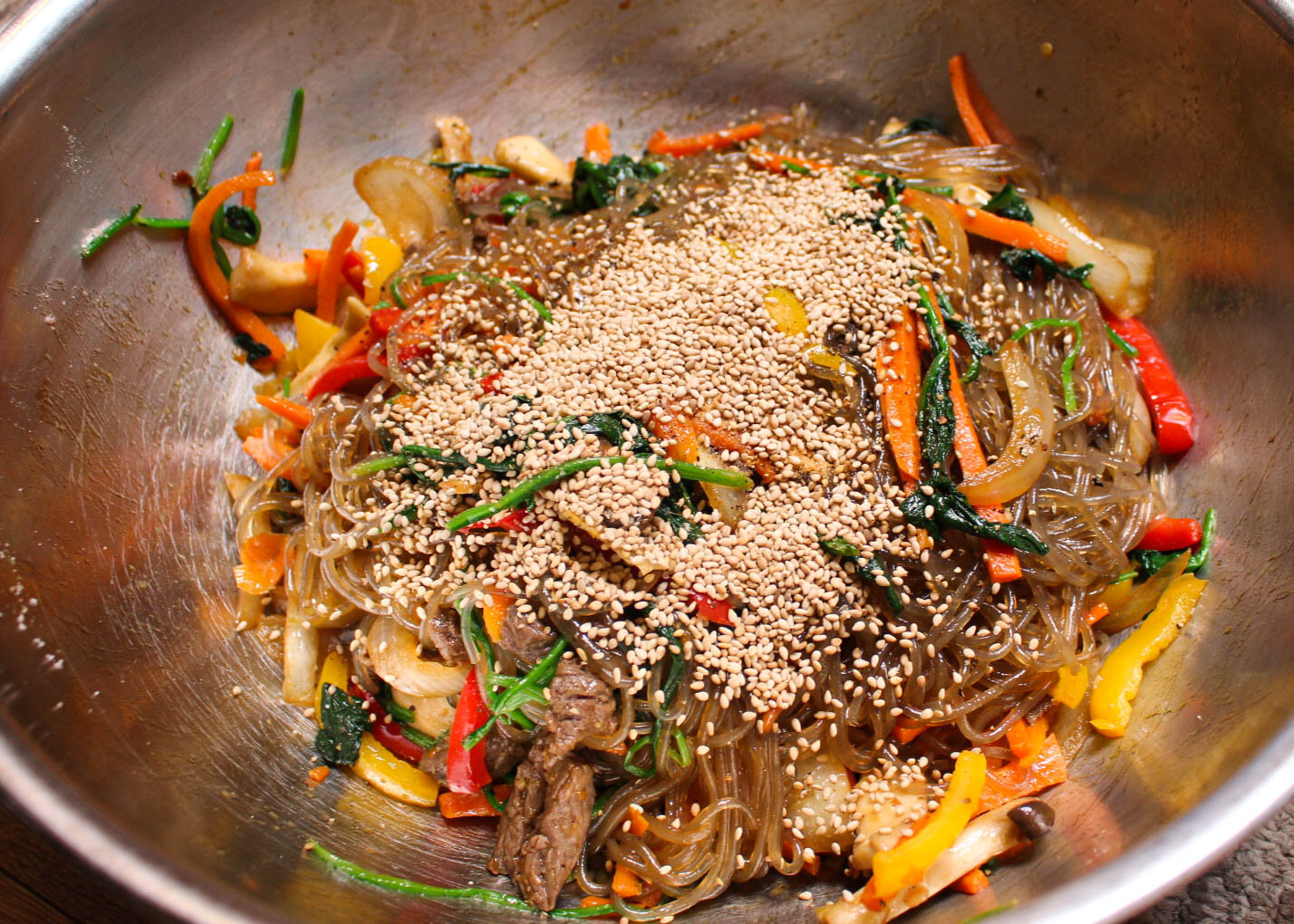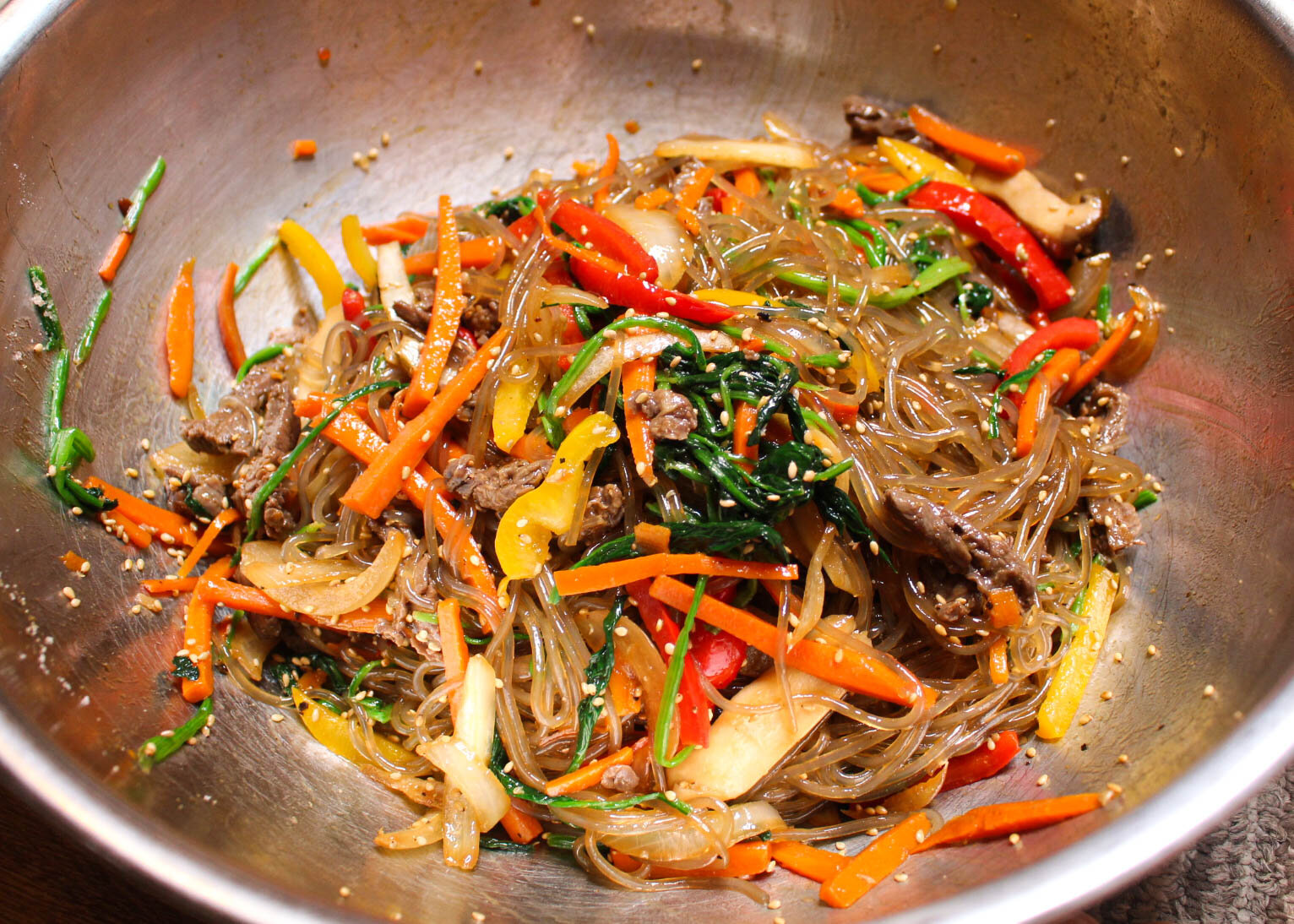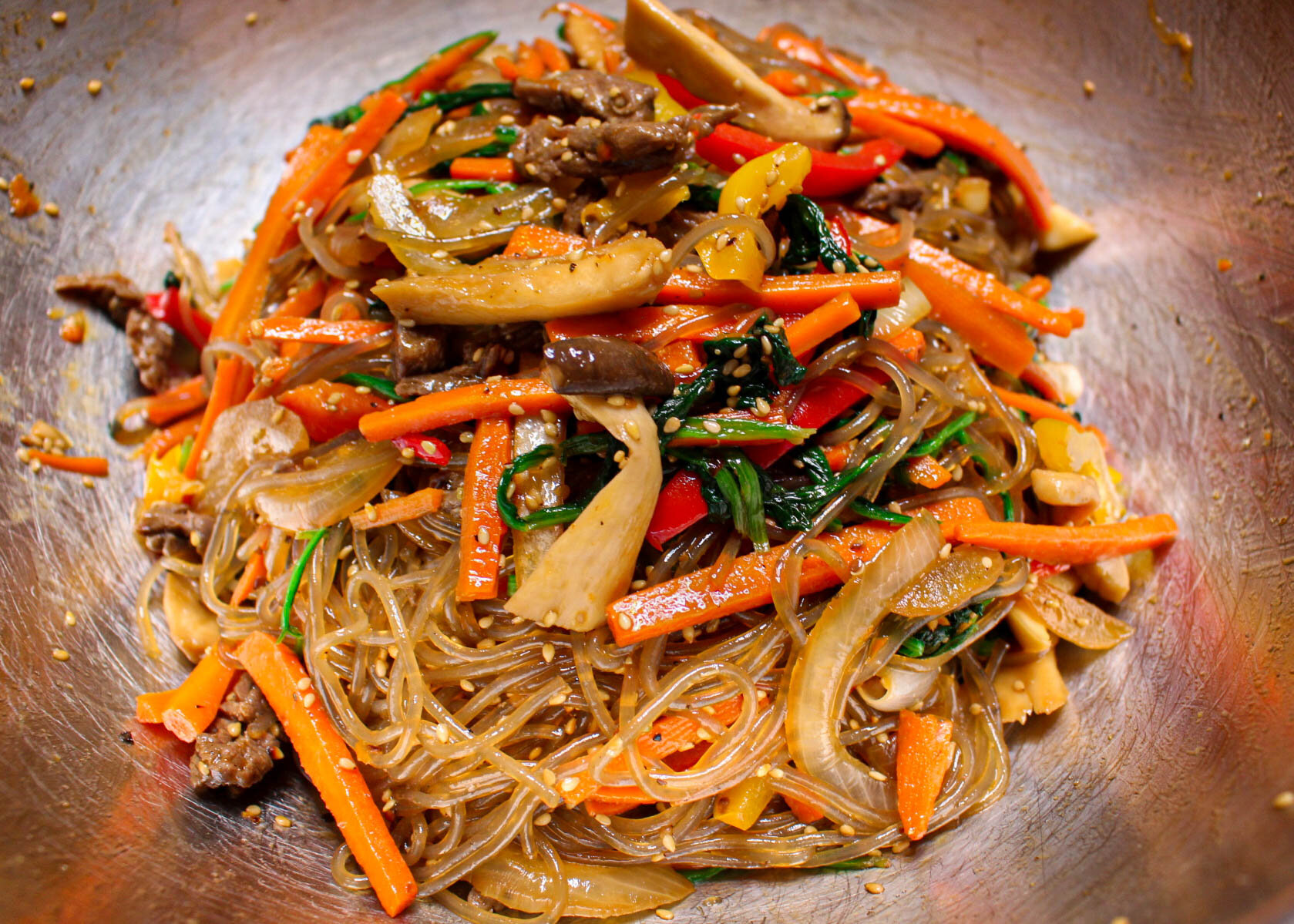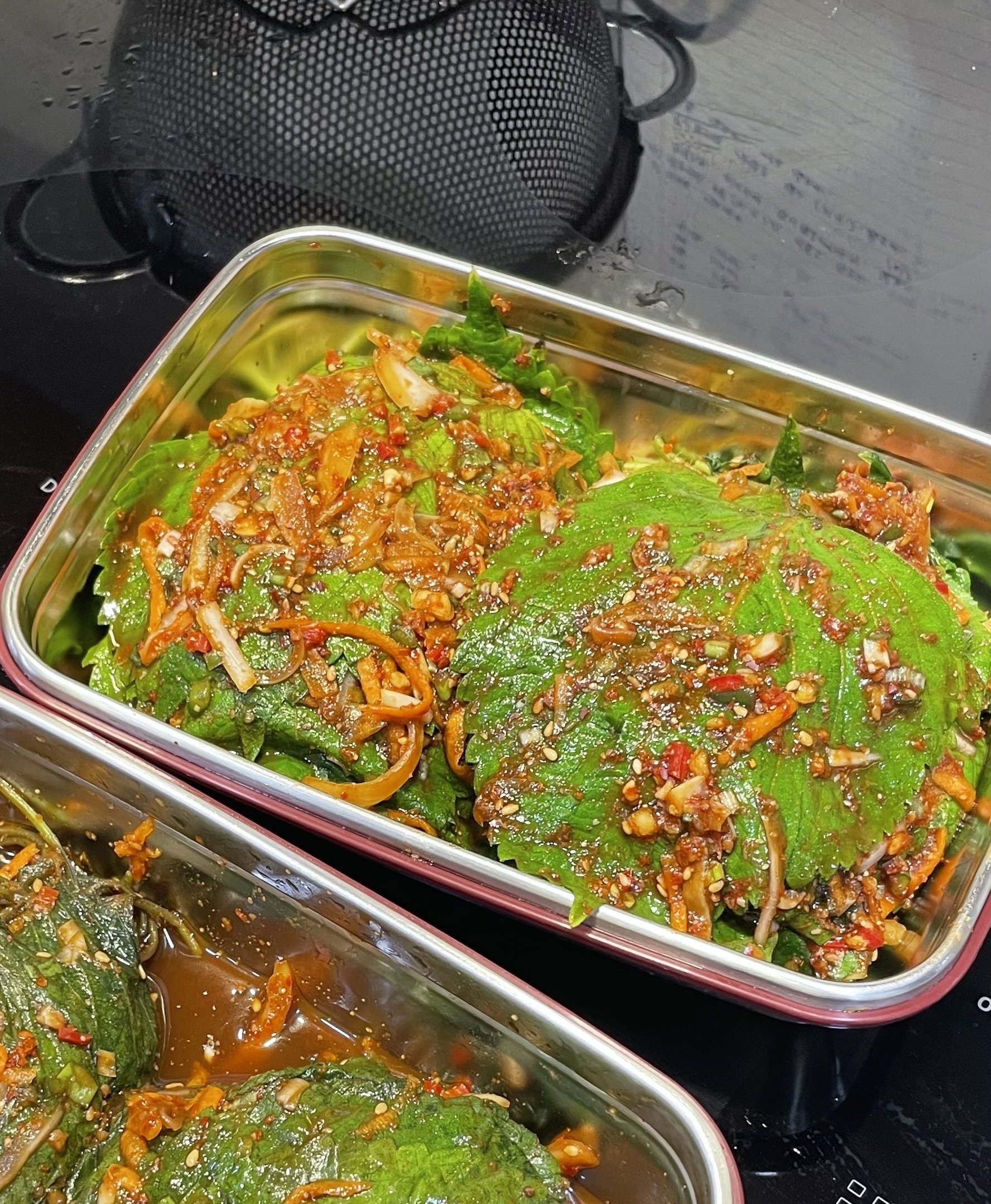The BEST Japchae Recipe (Korean Glass Noodle Stir Fry) | 잡채
authentic. mom’s recipe. simply the best
Pronounced: jahp-chae
What: Japchae is a sweet and savory dish of stir-fried glass noodles and vegetables that is popular in Korean cuisine. This is my mom’s japchae recipe. Everyone that has tried her japchae says it’s hands-down the BEST. And I full-heartedly agree without any bias. I have tried japchae at 5-star restaurants in Korea, and this japchae made by my mom still ranks at #1.
Taste: Sweet and savory flavorful glass noodles with perfectly seasoned vegetables and steak throughout.
How It’s Made: Marinate meat. Blanch & sauté vegetables separately. Cook meat. Cook and season noodles. Add to one large bowl. Season all together. Mix. Enjoy.
What to Serve it With: Usually eaten as is. We like to have this as a side dish with some soy sauce pickles. I’ll link a recipe to the pickles here once I write it up :).
Notes & Tips:
Noodle brand matters.
Buy either Wang Korea or Ottogi Korean Vermicelli Noodles. These are the brands my Mom recommends because of the good quality— both sold at Korean grocery stores.
These are NOT the same as Vietnamese vermicelli noodles by the way!
My Mom’s secret? Sauté the vegetables separately. This is key.
Mushrooms are optional.

Japchae (Korean Glass Noodle Stir Fry) | 잡채
Ingredients
- 260g Korean sweet potato starch noodles / glass noodles (We use Wang Korea Noodle brand or Ottogi... important see notes)*
- 0.5 lb Beef Flap Steak (any steak is fine, just make sure it's thinly cut)
- 1 large bunch Korean spinach, with stems attached (regular spinach is fine, NO baby spinach or packaged spinach) (285g)
- 2 oyster mushrooms (about 1 package of regular mushrooms) (150g or 2 cups chopped)
- 2 large carrots (300g)
- 1 red bell pepper
- 1 brown onion
- Garlic, minced
- Soy Sauce (We use regular Kikkoman)
- Sesame Oil
- Pink Salt
- Sugar
- Black Pepper
- Dasida Beef Stock Powder (We use CJ Dasida)
- Sesame Seeds, roasted
Instructions
- Trim off excess fat on beed. Cut beef into bite size pieces (size of a chicken nugget for a lack of better words).
- In a small bowl, add the beef and the following marinade ingredients: 1/2 Tbsp soy sauce, 1 tsp sesame oil, 1/2 Tbsp white sugar, 1/2 Tbsp garlic (minced), and black pepper.
- Mix, cover, and refrigerate.
- Wash 1 bunch of large spinach (285g). Do NOT cut off stems. Set aside in a strainer.
- Blanch spinach: In a large pot, add water halfway through (there needs to be enough space to blanch spinach). Add 1 tsp of pink salt. Heat on medium high to high heat. Let water come to boil. Prepare a separate large bowl with cold water.
- Once water is boiling, blanch spinach: Use a tong to grab a handful of spinach and submerge in boiling water, swirling it around just until the spinach transforms into a rich, deep green (about 15 seconds). Immediately submerge spinach into cold water, then run it under cold water, set aside in strainer. Repeat until all spinach is blanched and ran under cold water. Do not discard boiling water- leave it on the stove, to blanch next vegetable.
- Let the spinach sit in the strainer for 10 min. Then, grab blanched spinach by the handful and squeeze by the fist until no liquids drip out of your palm (don't over squeeze). Repeat until all spinach is squeezed and refrigerate in an airtight container.
- This ended up being 108g or 1 & 1/2 cup of blanched spinach.
- Wash 2 oyster mushrooms (150g) and cut into strips (2-3 inches, 1cm thick). If using regular mushrooms, cut as regular but make sure there's some thickness to your cut mushrooms (about 1cm thick).
- Blanch mushrooms in the same boiling water and pot we used for spinach (about 40 seconds per blanch). Set aside in a strainer.
- Run blanched mushrooms under cold water. Then, grab mushrooms by the handful and squeeze by the fist until no liquids drip out of your palm (don't over squeeze). Repeat until all mushrooms are squeezed and set aside in a large mixing bowl. This ended up being 95g or 1 cup of cooked mushroom.
- Wash, peel skin off, and slice 2 large carrots (300g) into thin strips (2-3 inches tall, 0.5cm thick).
- Heat a large pot (you can use the same one we boiled water in, just empty it out) with a good amount of oil to sauté carrots. Once oil is heated, add all sliced carrots into the pot. Drizzle more oil to coat all carrots. Sauté carrots by occasionally mixing it around, and add more oil when dry (all carrots should be oiled).
- Once carrots loosen up, season with a salt, sugar, black pepper, and 1/4 tsp of dasida. No need to season too much, as we will season all ingredients at the end.
- Continue to sauté until carrot is cooked through, but make sure it has some crunch to it (don't overcook that it becomes flimsy). Set aside in a large mixing bowl. This ended up being 200g or 1 & 3/4 cup of cooked carrots.
- Wash and slice 1 bell pepper into strips.
- Like the carrots, heat large pot with oil and sauté bell pepper strips. Once it loosens up, season by sprinkling in some salt, sugar, and black pepper. Add more oil if needed. Continue to cook until bell pepper is cooked through but do NOT overcook (it should have a crunch to it). Set aside in a large mixing bowl. This ended up being 142g or 1 cup of cooked bell pepper.
- Like the bell peppers, cut 1 brown onion into strips. Heat large pot with oil and sauté onion strips. Once it loosens up, season by sprinkling in some salt, sugar, and black pepper. No need to season too much, as we will season all ingredients at the end. Add more oil if needed.
- Continue to cook until bell pepper is cooked through but do NOT overcook (it should have a crunch to it). Set aside in a large mixing bowl. This ended up being 184g or 1 & 3/4 cup of cooked bell pepper.
- In the same large pot, add oil and sauté blanched mushrooms. Once it loosens up, season by sprinkling in some salt, sugar, and black pepper. No need to season too much, as we will season all ingredients at the end. Add more oil if needed.
- Continue to cook until mushroom is cooked through but do NOT overcook (it should have a crunch to it). Set aside in a large mixing bowl.
- In the same large pot, heat some oil and cook beef. Season beef with 1 Tbsp soy sauce, 1/2 Tbsp white sugar, and 1/2 tsp dasida (beef stock powder).
- If excess liquid forms, absorb with a paper towel. Once fully cooked, set aside in a large mixing bowl. We'll still be using the pot later to cook the noodles, so keep the beef oils in there and leave as is.
- Take out blanched spinach out of the fridge. Snip spinach into smaller pieces (3in long).
- In a small mixing bowl, season spinach with 1/4 tsp salt, 1 tsp sesame oil, and 1/8 tsp dasida (beef stock powder). Mix gently and thoroughly. Set aside in a large mixing bowl. Give the mixing bowl with all the vegetables and meat a quick mix.
- We are going to boil the noodles now. In the same pot we cooked the beef in, there should be beef oils at the bottom of the pot. To that pot, add in enough water to cook noodles (we need oil in the water because it prevents the noodles from sticking). If you want to use a fresh new pot, then add a drizzle of oil to the water.
- Boil over high heat. Once it is boiling, submerge the noodles into the water. Turn OFF the heat and cover pot with lid. Set a timer for 6 minutes. Watch the timer closely! - You really have to prevent overcooking these noodles!
- After 6 minutes, taste test the noodles. It should NOT be al dente. It should be chewy and not overcooked. If al dente, cook for another 1 minute with the lid on top, and check again.
- Remove noodles and strain. Do NOT run it under water. Add it a medium bowl (we need to season the noodles separately on its own).
- Add the following to seasoning to noodles: 4 Tbsp soy sauce, 2 Tbsp white sugar, and 2 Tbsp sesame oil.
- Gently mix with hands, be careful it's hot! (tip: use disposable food gloves). Add noodles to large bowl with all the vegetables.
- Mix noodles with vegetables so that everything is well mixed together. Then, add the following seasoning: 1 Tbsp soy sauce , 1 Tbsp white sugar, 1/4 cup sesame seeds, roasted, 1 tsp Dasida Beef Stock Powder, 1/2 tsp Himalayan Pink Salt, and Black Pepper.
- Gently mix with hands (tip: use disposable food gloves). Give it a taste, and adjust as needed. It will taste a bit salty but once the japchae sits for 30 minutes, all those flavors will fuse together and be less salty.
instructions with pictures
Marinade Beef
Cut beef into bite size pieces, trimming off excess fat. Add to small bowl and add the following seasoning:
1/2 Tbsp soy sauce
1 tsp sesame oil
1/2 Tbsp white sugar
1/2 Tbsp garlic (minced)
Black pepperMix, cover, and refrigerate.
Blanch Spinach
Wash 1 bunch of large spinach (285g). Do NOT cut off stems. Set aside in a strainer.
Blanch spinach: Fill half of a large pot with water (there needs to be enough space to blanch spinach). Add 1 tsp of pink salt. Turn on heat on medium high to high heat. Let water come to boil. Meanwhile, prepare a separate large bowl with water to dunk blanched spinach into. Set it aside near the stovetop.
Once water is boiling, blanch spinach: Use a tong to grab a handful of spinach and submerge in boiling water for about 15 seconds, swirling it around just until the spinach transforms into a rich, deep green. Immediately submerge spinach into the prepared separate large bowl of cold water. Then, take blanched spinach to the sink and run it under cold water again to cool down. Set aside in strainer.
Repeat until all spinach is blanched, dunked in cold water, and ran under cold water. Do not discard boiling water- leave it on the stove, to blanch next vegetable.Let the blanched spinach sit in the strainer for 10 minutes. Then, grab blanched spinach by the handful and squeeze until no liquids drip out of your palm (don’t over squeeze). Repeat until all spinach is squeezed and refrigerate in an airtight container.
This ended up being 108g or 1 & 1/2 cup of blanched spinach.
Blanch Mushrooms
Wash 2 oyster mushrooms (150g) and cut into strips (2-3 inches, 1cm thick). If using regular mushrooms, cut as regular but make sure there's some thickness to your cut mushrooms (about 1cm thick).
Blanch mushrooms in the same boiling water and pot we used for spinach (about 40 seconds per blanch). Set aside in a strainer.
Run blanched mushrooms under cold water. Then, grab mushrooms by the handful and squeeze \ until no liquids drip out of your palm (don’t over squeeze). Repeat until all mushrooms are squeezed and set aside in a large mixing bowl. This ended up being 95g or 1 cup of cooked mushroom.
Sauté Carrots
Wash, peel skin off, and slice 2 large carrots (300g) into thin strips (2-3 inches tall, 0.5cm thick).
Heat a large pot (use same pot we used to blanch , just empty it out) with a good amount of oil to sauté carrots. Once oil is heated, add all sliced carrots into the pot. Drizzle more oil to coat all carrots. Sauté carrots by occasionally mixing it around, and add more oil when dry (all carrots should be oiled).
Once carrots loosen up, season with a salt, sugar, black pepper, and 1/4 tsp of dasida. No need to season too much, as we will season all ingredients at the end.
Continue to sauté until carrot is cooked through, but make sure it has some crunch to it (don't overcook that it becomes flimsy). Set aside in a large mixing bowl. This ended up being 200g or 1 & 3/4 cup of cooked carrots.
Sauté Bell Pepper
Wash and slice 1 bell pepper into strips.
Like the carrots, heat large pot with oil and sauté bell pepper strips. Once it loosens up, season by sprinkling in some salt, sugar, and black pepper. Add more oil if needed. Continue to cook until bell pepper is cooked through but do NOT overcook (it should have a crunch to it). Set aside in a large mixing bowl. This ended up being 142g or 1 cup of cooked bell pepper.
Sauté Onion
Like the bell peppers, cut 1 brown onion into strips. Heat large pot with oil and sauté onion strips. Once it loosens up, season by sprinkling in some salt, sugar, and black pepper. No need to season too much, as we will season all ingredients at the end. Add more oil if needed.
Continue to cook until bell pepper is cooked through but do NOT overcook (it should have a crunch to it). Set aside in a large mixing bowl. This ended up being 184g or 1 & 3/4 cup of cooked bell pepper.
Sauté Mushrooms
In the same large pot, add oil and sauté blanched mushrooms. Once it loosens up, season by sprinkling in some salt, sugar, and black pepper. No need to season too much, as we will season all ingredients at the end. Add more oil if needed.
Continue to cook until mushroom is cooked through but do NOT overcook (it should have a crunch to it). Set aside in a large mixing bowl.
Cook Beef + More Seasoning
In the same large pot, heat some oil and cook beef. Season beef with 1 Tbsp soy sauce, 1/2 Tbsp white sugar, and 1/2 tsp dasida (beef stock powder).
If excess liquid forms, absorb with a paper towel. Once fully cooked, set aside in a large mixing bowl. We'll still be using the pot later to cook the noodles, so keep the beef oils in there and leave as is.
Season Spinach
Take out blanched spinach out of the fridge. Snip spinach into smaller pieces (3in long).
In a small mixing bowl, season spinach with 1/4 tsp salt, 1 tsp sesame oil, and 1/8 tsp dasida (beef stock powder). Mix gently and thoroughly. Set aside in a large mixing bowl. Give the mixing bowl with all the vegetables and meat a quick mix.
Cook Noodles
We are going to boil the noodles now. In the same pot we cooked the beef in, there should be beef oils at the bottom of the pot. To that pot, add in enough water to cook noodles (we need oil in the water because it prevents the noodles from sticking). If you want to use a fresh new pot, then add a drizzle of oil to the water.
Boil over high heat. Once it is boiling, submerge the noodles into the water. Turn OFF the heat and cover pot with lid. Set a timer for 6 minutes. Watch the timer closely! - You really have to prevent overcooking these noodles!
After 6 minutes, taste test the noodles. It should NOT be al dente. It should be chewy and not overcooked. If al dente, cook for another 1 minute with the lid on top, and check again.
Remove noodles and strain. Do NOT run it under water. Add it a medium bowl (we need to season the noodles separately on its own).
Season Noodles
Add the following to seasoning to noodles:
4 Tbsp soy sauce
2 Tbsp white sugar
2 Tbsp sesame oilGently mix with hands, be careful it's hot! (tip: use disposable food gloves). Add noodles to large bowl with all the vegetables.
FINAL STEP: Season all together to make Japchae
Mix noodles with vegetables so that everything is well mixed together. Then, add the following seasoning:
1 Tbsp soy sauce
1 Tbsp white sugar
1/4 cup sesame seeds, roasted
1 tsp Dasida Beef Stock Powder
1/2 tsp Himalayan Pink Salt
Black Pepper.Gently mix with hands (tip: use disposable food gloves). Give it a taste, and adjust as needed. It will taste a bit salty but once the japchae sits for 30 minutes, all those flavors will fuse together and be less salty.
Serve immediately! This tastes best when eaten fresh. Refrigerate leftovers, but leftovers won’t taste as good as fresh. To heat up, microwave or heat up in a heated pan.

